7-Day Emilia Romagna Itinerary: How to Explore the Top Cities and Must-See Sights

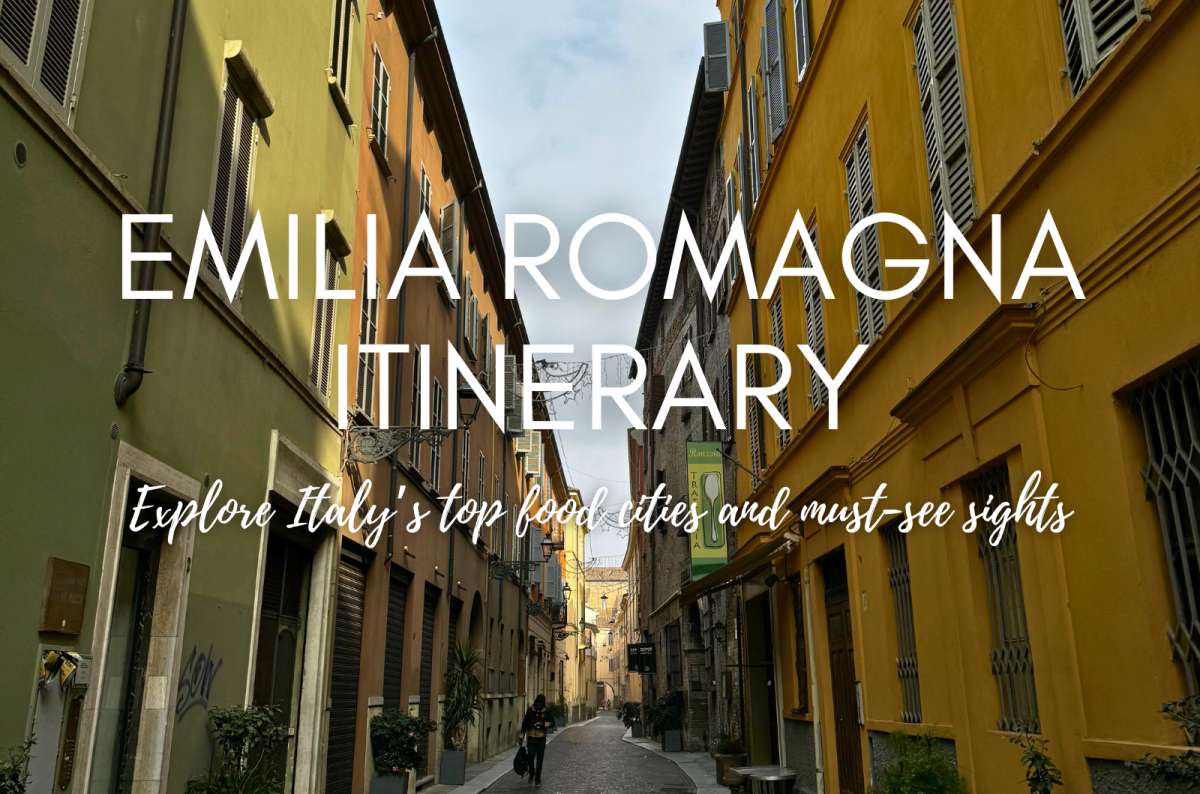
What you’ll find in this article:
TL;DR: How to spend a week in Emilia-Romagna?
Where to stay for this Emilia Romagna Itinerary
Day 1 on Emilia Romagna itinerary: Modena—Cars, Pavarotti, and Modena’s Cultural Highlights
Day 2 on Emilia Romagna itinerary: Modena Old Town and Food Tour
Day 3 on Emilia Romagna itinerary: Day Trip to Parma, Italy’s Food Capital
Day 4 of Emilia Romagna itinerary: Hiking Pietra di Bismantova
Day 5 of Emilia Romagna itinerary: Day Trip to Bologna
Day 6 of Emilia Romagna itinerary: Ravenna Day Trip: the best UNESCO mosaics
Day 7 of Emilia Romagna itinerary: San Marino and Italy in Miniature
Pro travel tips for San Marino
Do you need a car in Emilia Romagna?
Planning an Emilia Romagna itinerary? Good. You’re in the right place. This is my 7-day guide to Emilia Romagna’s best cities, incredible food stops, and fun things to do—based entirely on my own travels across Italy. Note: This itinerary is best done with a car (and an appetite!).
I’ve visited Emilia Romagna more than once (and Italy more times than I can count). It’s my favorite country in Europe, after all. The Emilia Romagna region is a traveler’s goldmine: Parmigiano Reggiano, prosciutto di Parma, picturesque cities, Ferrari and Lamborghini factories, Roman and Byzantine mosaics… and gorgeous weather too!
This itinerary covers the best Emilia Romagna cities—Bologna, Parma, Modena, Ravenna, Ferrara, San Marino, and more—optimized for a 7-day itinerary.
Read more from my Italy travel blog.
Sometimes, all you need to do is take the first step... I've filtered out the best hotels in Emilia Romagna for you
Save it for yourself to come back to later, or share with your friends on social media!

Tastes, views, and history—highlights from my 7-day Emilia Romagna itinerary
What you’ll find in this article:
I put together the perfect amount of information you’ll need to plan your own Emilia Romagna itinerary, things to do in Emilia Romagna including entry prices for attractions, where to eat, driving distances, and how to split your time in each place. I’ll tell you exactly where I stayed, because I’d book a room in these two hotels again in a heartbeat.
Fun fact: 25% of Emilia Romagna is mountains, 48% is flat farmland (unusual for Italy), and it’s home to both Europe’s worst air quality and some of its best food. Fair trade-off, honestly.
TL;DR: How to spend a week in Emilia-Romagna?
- Day 1: Modena—Pavarotti’s house, Maseratis and Ferraris
- Day 2: Modena—Parmigiano Reggiano tasting, traditional balsamic vinegar, Romanesque architecture
- Day 3: Day trip to Parma—Frescoes, churches, prosciutto, and Parmesan
- Day 4: Day trip to Pietra di Bismantova—A break from cities—hiking in Emilia Romagna
- Day 5: Day trip to Bologna—Porticoes, more churches, and killer pasta
- Day 6: Ravenna—Insane mosaics at 8 UNESCO sites
- Day 7: San Marino + Italy in Miniature—Start with tiny gondolas, end with a sunset over a medieval fortress

7-day Emilia-Romagna itinerary map showing the places you’ll visit and the order you’ll see them in
Where to stay for this Emilia Romagna Itinerary
I recommend you stay in just two hotels for a full week—You minimize moving around too much + both hotels are tested by me and strongly approved.
Base yourself in Modena for the first 5 nights of this Emilia Romagna itinerary (ideally even for the night before your first day). I know it’s not the obvious choice, but I’ve said it before: Modena is the best city in Emilia Romagna. Plus, the hotel I stayed in there—RMH Modena Des Arts—was one of my absolute favorites in all of Italy.
From Modena, you’ll easily reach Parma, Bologna, and Pietra di Bismantova on day trips.
For the final 2 nights (or 3 if you stay for one more night after San Marino), move east and stay at Relais Villa Margherita, just outside of Ravenna and San Marino—two more essential things to see in Emilia Romagna. It’s another place I can fully vouch for—so serene and with a garden view of Mount Titano.
Day 1 on Emilia Romagna itinerary: Modena—Cars, Pavarotti, and Modena’s Cultural Highlights

Modena’s stunning Romanesque cathedral
Main sites visited:
- Ferrari Museum, Maranello (EUR 27)
- Casa Museo Luciano Pavarotti (EUR 12)
- Panini Motor Museum (Free)
- Enzo Ferrari Museum (EUR 22)
- Palazzo Ducale di Modena (Free, exterior only)
- Museo Civico di Modena (Free or cheap)
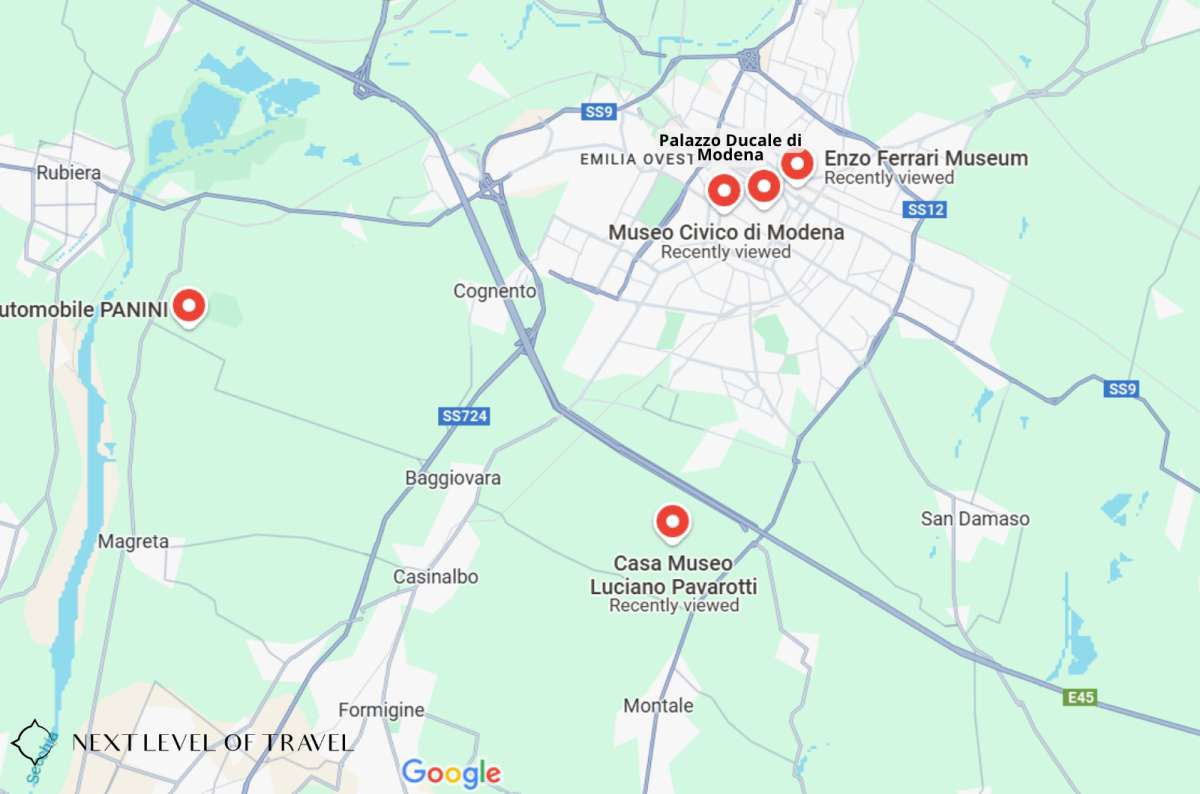
Map of key cultural attractions near Modena for your first day
Restaurant tips:
- Franceschetta58 – Modern, informal version of Bottura’s empire.
- Al Duomo – For a traditional Modenese dinner near the cathedral.
Hotel recommendations:
Morning: Ferrari and Pavarotti Museums
When listing the top things to do in Emilia Romagna, it’s impossible to ignore the region’s obsession with fast, loud, and beautiful cars. It’s not every day you see 3 car museums in a single day, but this is Modena, so...
Start at the Ferrari Museum in Maranello (EUR 27 + EUR 1/hour for parking). I’ll be honest—I wanted to be able to marinate in a hall surrounded by every iconic Ferrari ever made, and expected a hi-tech, hands-on exhibit. But this museum’s more like a fancier showroom where you just walk and look. That said, the SF90 Stradale, the legendary F40, and the Ferrari 315 still made me fangirl.
Then drive 10 minutes to Casa Museo Luciano Pavarotti (EUR 12). We thought it was surprisingly great. It’s one of the most heartfelt museums I’ve ever visited. The man had charm, and his personality still shines through in his house—his art, awards, even his bathrobe are still there.
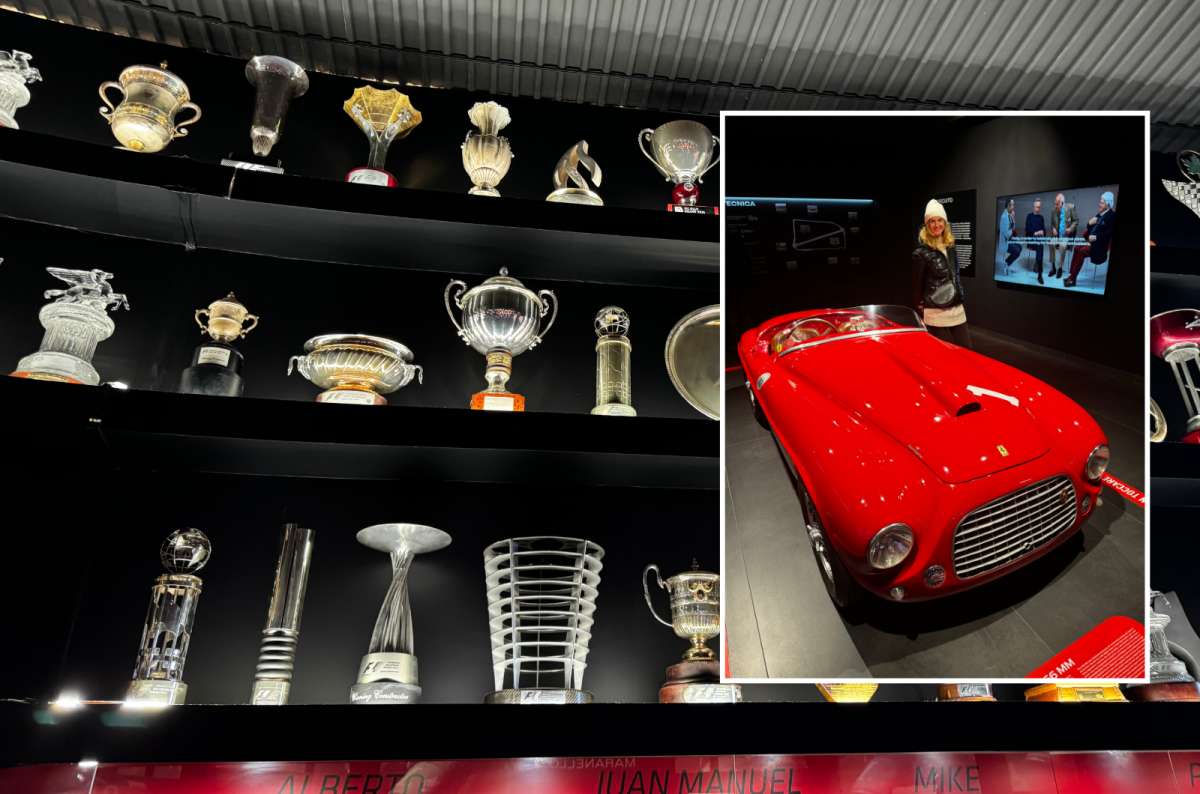
Still waiting for them to hand me the keys
Afternoon: More car museums in Modena
After lunch (I’ll get to food later), head to the Panini Motor Museum (free). This place is epically underrated. It’s on a working farm (weird, yes) and has one of the best private Maserati collections I’ve seen. Not sleek like the Ferrari place, but overflowing with stuff to look at.
Next, one final car stop for your first day of your Emilia Romagna itinerary: the Enzo Ferrari Museum (EUR 22 + EUR 1/hour for parking). This museum is about Enzo’s life and legacy, not so much about the cars. I thought the modern glass building was very cool, and it was interesting to get to know the man behind the brand.
Checking out some of Emilia Romagna's history
Back in Modena’s center, take a walk around Palazzo Ducale (free, exterior only). It’s huge and now houses the Italian Military Academy, but unless you get inside (which is rarely possible), it’s just a quick stop for a few photos. Take some time and stroll around Piazza Roma.
Wrap the day at Museo Civico di Modena, housed in the Palazzo dei Musei. It’s quiet, free, and gives you a better sense of Modena beyond just cars and cheese. Not a must-see in Emilia Romagna, but I always like to add context to my travels, so I went and spent an hour looking around. Especially interesting was the section dedicated to Modena’s artisans.
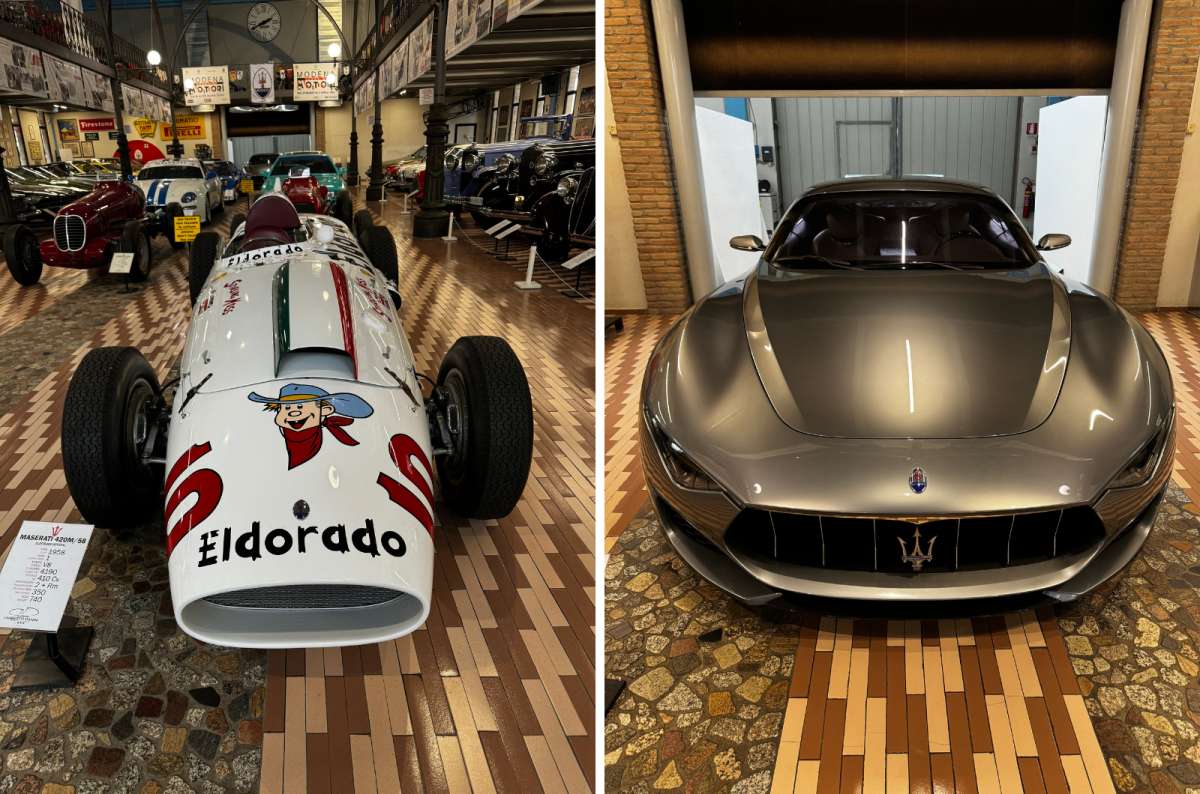
From retro racer to modern stunner—Maserati’s glow-up game is strong
Dinner like a Modenese
Make sure to grab dinner at Franceschetta58 (the casual sibling of Massimo Bottura’s three-starred Osteria Francescana) or Al Duomo for a more traditional Italian meal. Make sure to make reservations—Modena may be quiet, but it doesn’t mess around when it comes to food.
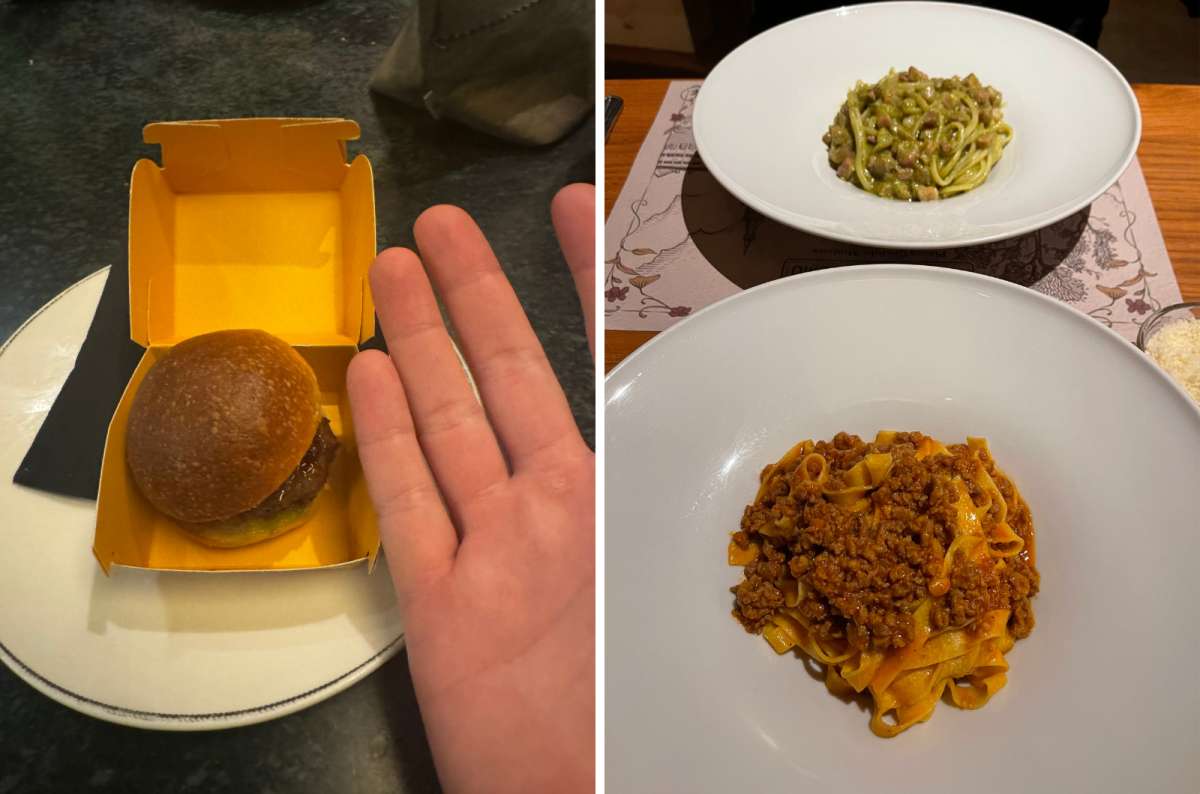
Franceschetta58 gave us a burger the size of a coin. Al Duomo said, “Here’s a mountain of ragù. Buon appetito.”
Day 2 on Emilia Romagna itinerary: Modena Old Town and Food Tour
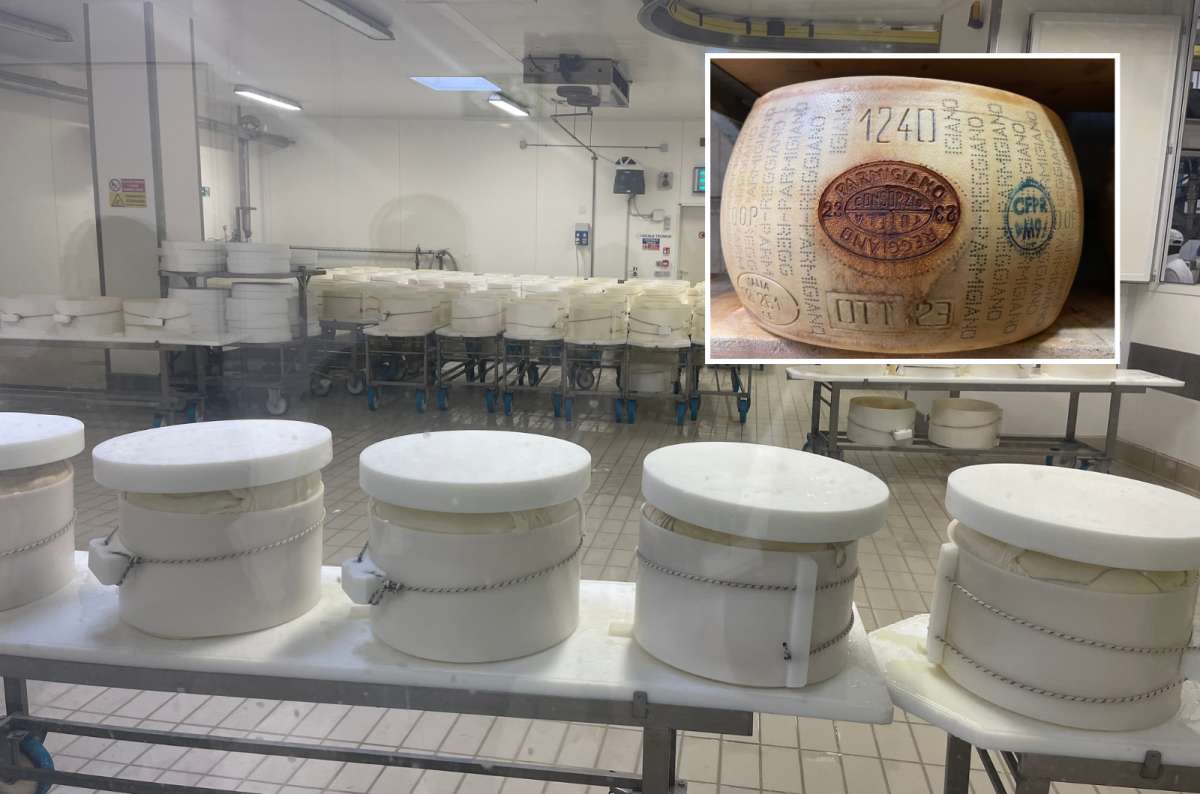
Witnessing Parmigiano Reggiano go from gooey blobs to Italy’s crown jewel of cheese
Main sites visited:
- 4 Madonne Cheese Factory (EUR 20)
- Acetaia Giusti (Free)
- Duomo di Modena (Free)
- Torre Ghirlandina (EUR 3)
- Museo Archeologico (Free)
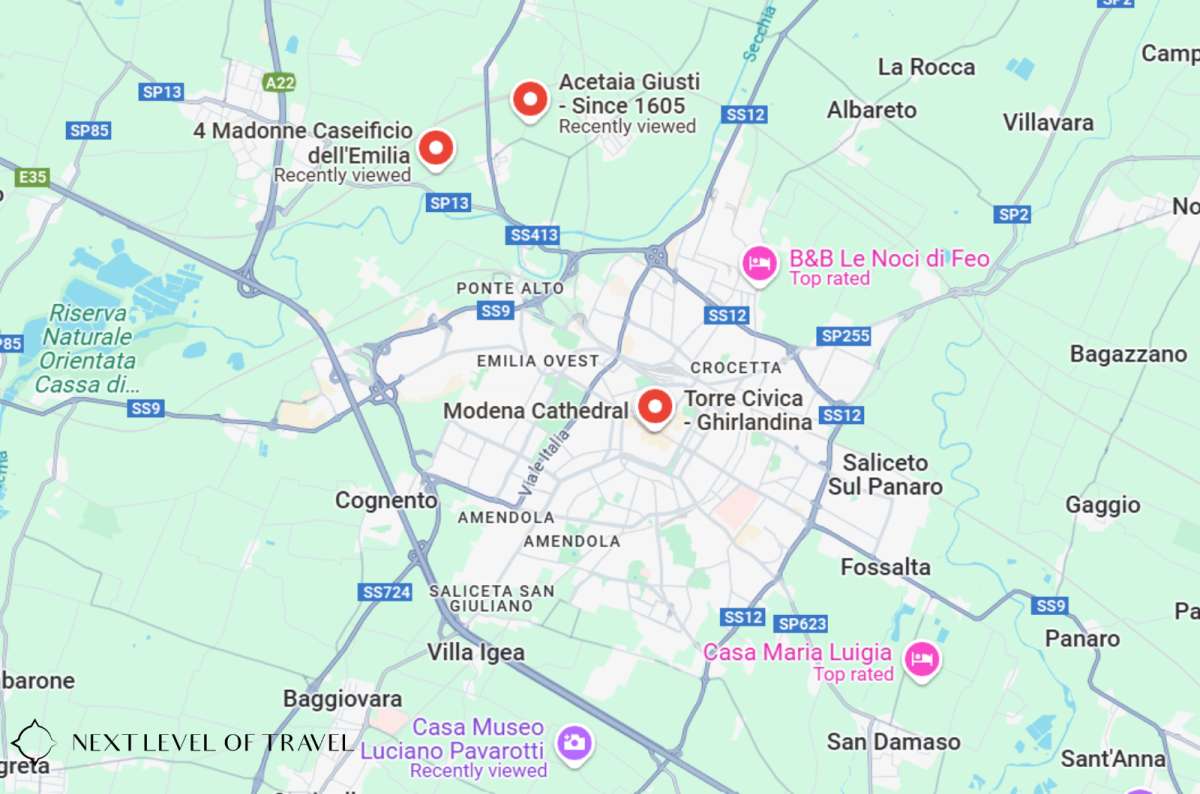
Map of landmarks for your second day in Modena
Restaurant tips:
- Franceschetta58 or Al Duomo, if not already done on Day 1. Both are worth repeating if you’re still in town.
Hotel recommendations:
Morning: Learning about Emilia Romagna cuisine
What better way to kick off day two of your Emilia Romagna itinerary than with a cheese factory! I The 4 Madonne Cheese Factory (EUR 20) was hands-down one of the best food experiences I’ve had in Emilia Romagna.
They showed us the entire cheese-making process—from milk to wheel—and I kid you not, it was so fascinating. Luckily, I didn’t overdo breakfast, because we even got to taste different-aged Parmigiano. You’ll also be shown their secret cracking technique with the almond-shaped knife.
Pro tip: Book ahead and bring a jacket—the aging rooms are cold.
Must-visit place in Modena: the vinegar museum
Right after, head to Acetaia Giusti (free). Even if you don’t care about vinegar (does anyone?), go. Traditional balsamic is an art form here, aged 12+ years in wooden barrels.
Again, be ready for tastings. I was blown away by how much flavor one drop packs. You’ll never touch supermarket vinegar again. Luckily, you can stock up on “souvenirs” to take home with you. Seriously, eating is the clear top thing to do in Emilia Romagna—it changes you for life.
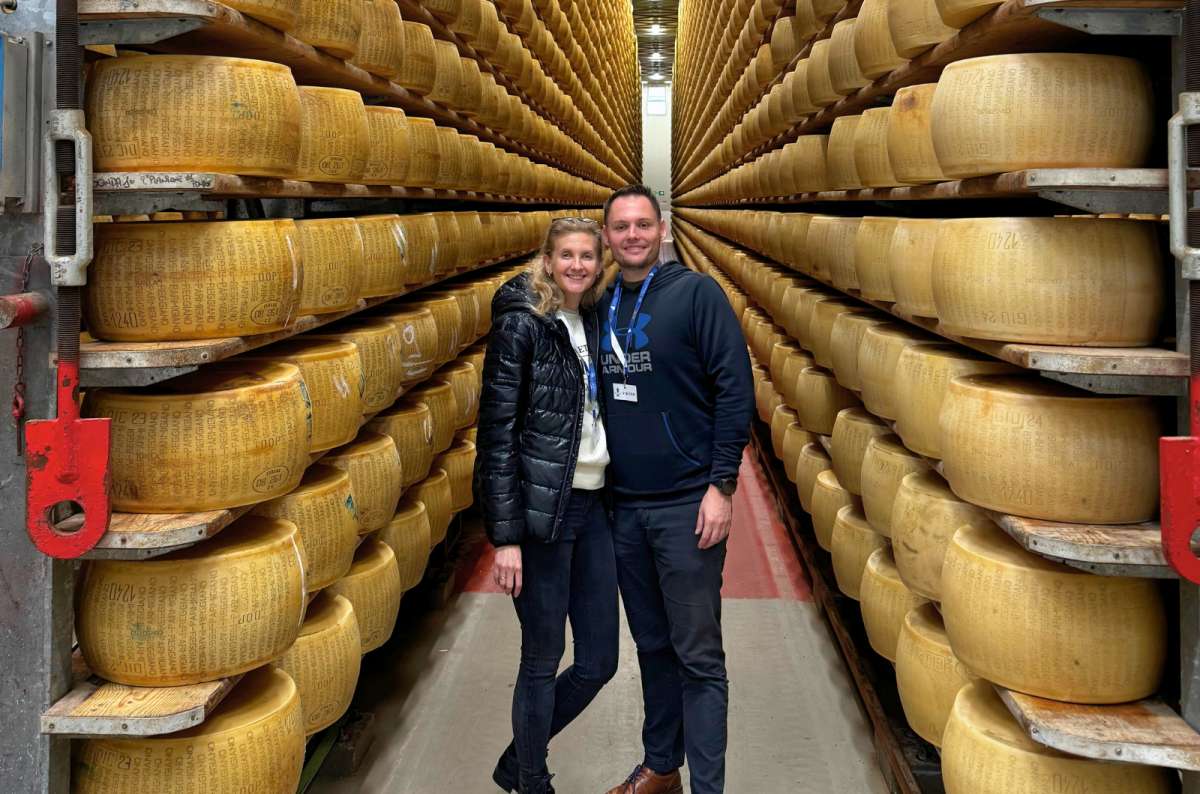
Surrounded by thousands of cheese wheels—and still the cheesiest thing here is our smiles
Afternoon: Visiting Modena Old Town
Now that you’ve seen (and tried and loved) Modena’s most famous and delicious exports, it’s time to take a proper look at the Old Town.
Start at the Duomo di Modena (free)—Modena’s cathedral—which is frankly spectacular and one of the most memorable things to see in Emilia Romagna. You’ll find carved lions, Romanesque columns, and a perfect “this-isn’t-for-tourists” atmosphere. It’s not flashy, certainly not like the Duomo in Siena, but it has real character.
Where to find the best views of Modena
Then climb the Torre Ghirlandina (EUR 3). The stairs are narrow and claustrophobic, and the view is good but not jaw-dropping—but it’s a ritual. You climb, you sweat, you see Modena from the top through old iron bars.
Don’t skip Piazza Grande and check out the Town Hall while you're there, then take a few minutes to explore the narrow streets around it. Just keep an eye on unexpected traffic—I was shocked by how cars here squeeze into some of the tightest turns!
This is why Emilia Romagna’s history is so interesting
Finally, head back to the Palazzo dei Musei and breeze through the Museo Archeologico (free). It’s a small space with mostly Roman and Etruscan relics, so it’s more focused than yesterday’s museum. You won’t need more than 30 minutes.
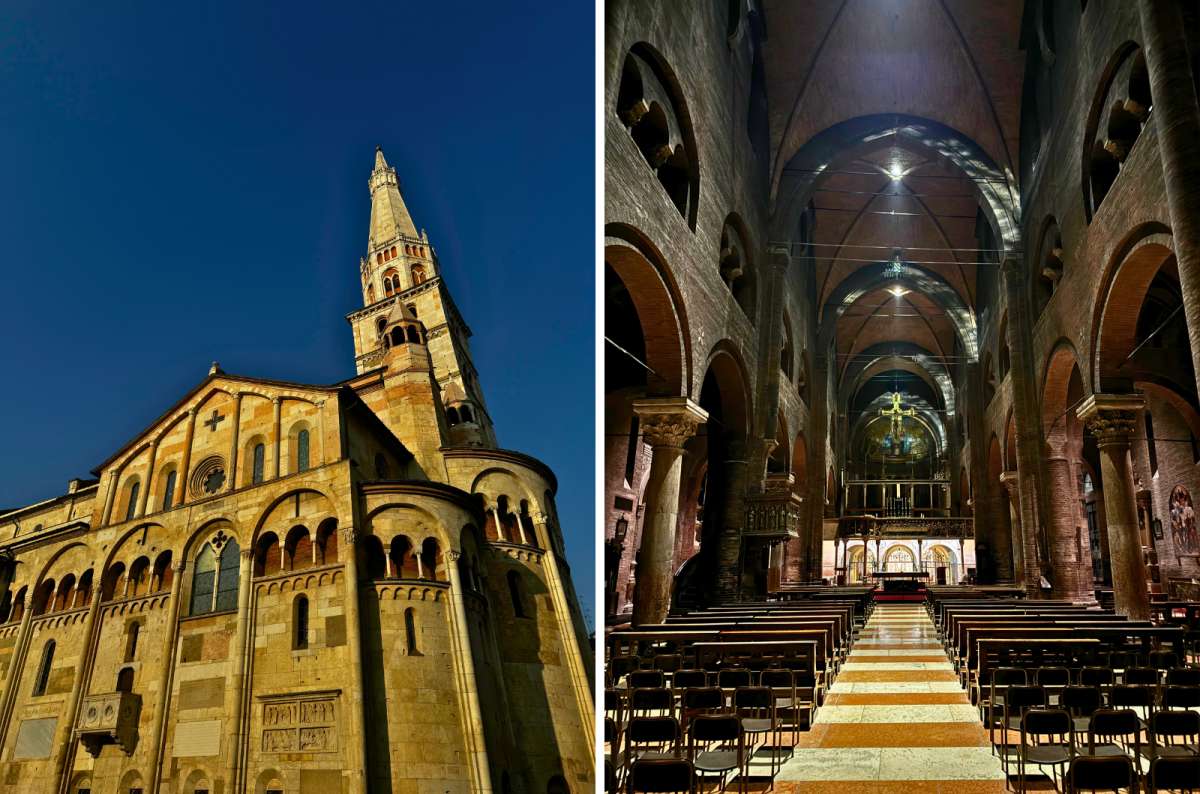
Modena’s Duomo—quietly stunning inside and out
Pro travel tips for Modena
-
Book factory tours in advance—especially the 4 Madonne Cheese Factory.
-
Visit on a weekday. Saturdays and Mondays are dead zones—many museums and food spots close.
-
Drive or don’t bother. Some of the best things to do in Modena are scattered outside the center (Ferrari, cheese, vinegar, etc.).
-
Eat early or starve—most restaurants shut down between lunch and dinner.
Day 3 on Emilia Romagna itinerary: Day Trip to Parma, Italy’s Food Capital
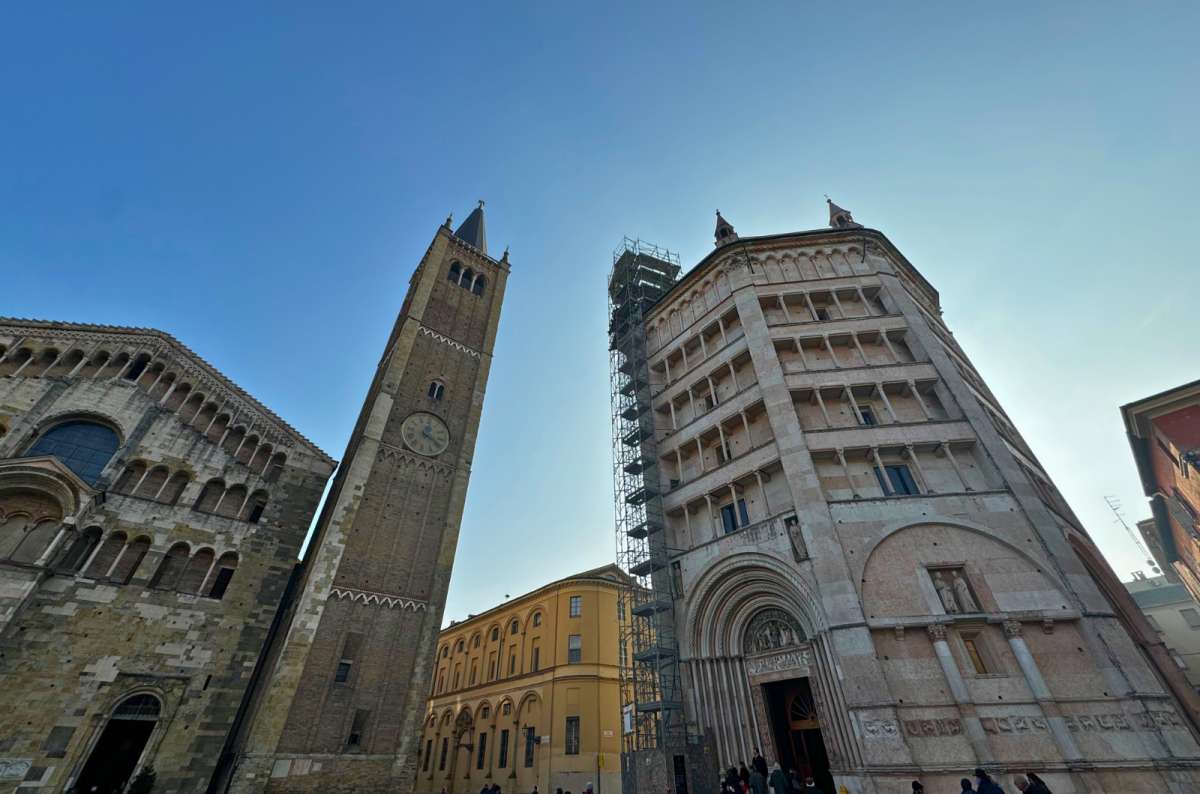
Parma’s holy trio: cathedral, bell tower, and baptistery
Main sites visited:
- Palazzo della Pilotta (Archaeological Museum, Gallery of Parma, Farnese Theater) – combined entry EUR 18
- Parma Baptistery (EUR 12, includes Diocesan Museum)
- Parma Cathedral (Free)
- Castello dei Burattini (Free)
- Sanctuary of Santa Maria della Steccata (Free)
- San Giovanni Evangelista (Free)
- Museo del Prosciutto di Parma (EUR 5)
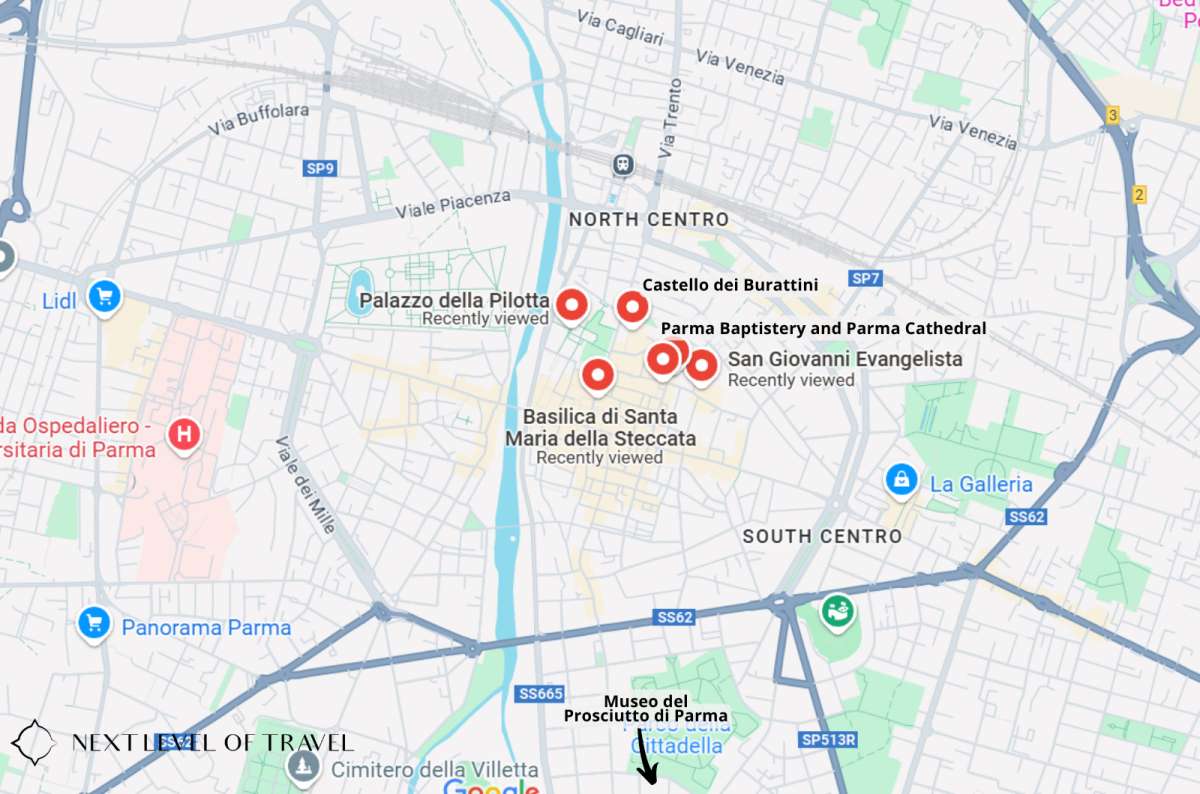
Day 3 of the Emilia-Romagna itinerary: Exploring Parma’s cultural gems
Restaurant tips:
-
Trattoria Ai Due Platani – Ranked 29th best restaurant in Italy; near Parma city center
Hotel recommendations:
-
RMH Modena Des Arts in Modena
Further reading:
Today is another day trip, this time to the tastiest city in Emilia Romagna—Parma. From Modena, it’s an easy 1-hour drive.
I love Parma. It’s much quieter than places like Florence or Venice, but the wealth is still obvious. The air quality is pretty bad, but when you’re eating the best meal of your life, breathing seems overrated anyway. I already want to go back, just writing about it.
Morning: Parma’s most important historical buildings
We started our day in Parma in Palazzo della Pilotta, home to the Farnese Theater, the Archeological Museum, and the Gallery of Parma (EUR 18 combo ticket). To me, the theater alone is worth the entry—a massive wooden structure rebuilt after WWII that, unbelievably, was once used for fake naval battles.
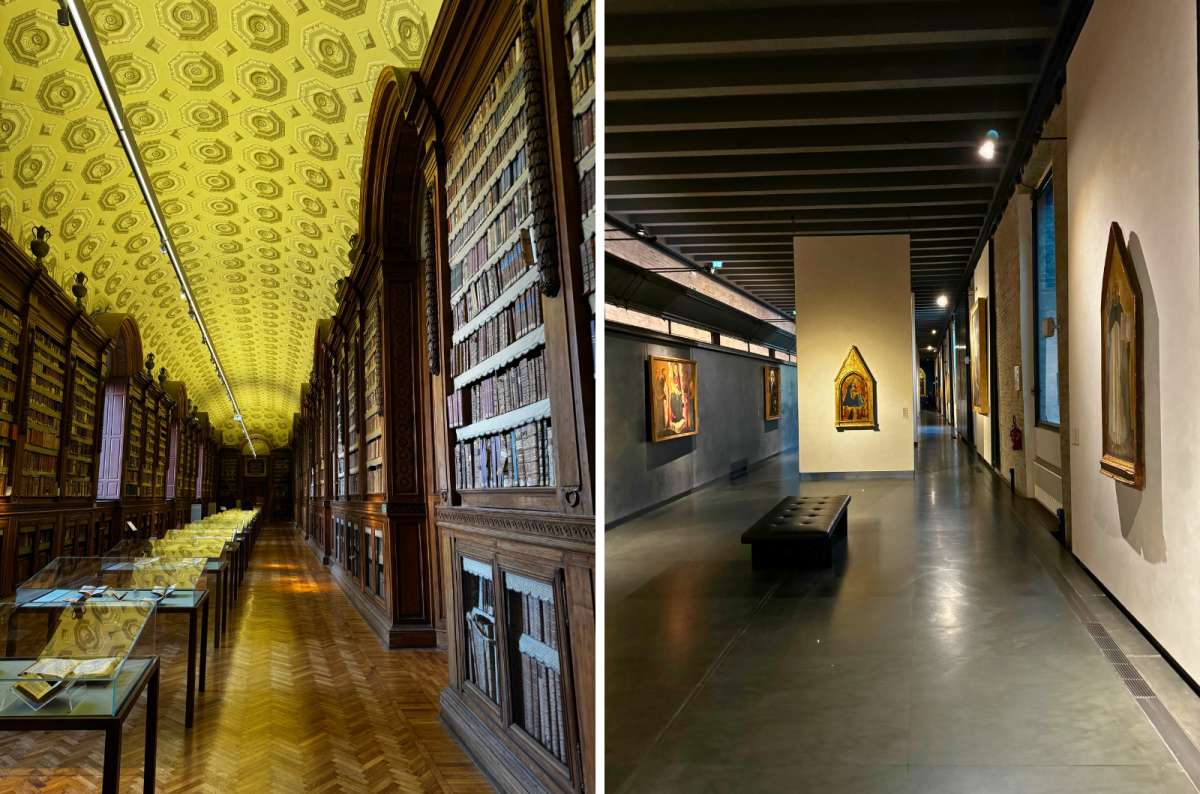
From ancient books to Renaissance art, all in a morning’s walk through Parma
Then we walked five minutes to Piazza del Duomo, which is where you’ll find the octagonal Parma Baptistery (EUR 12), built with pink Verona marble.
Visit Parma Cathedral, it’s mind-boggling
And now the big kahuna: the mind-blowing Parma Cathedral (free). From the outside, the Duomo seems almost forgettable, but inside—wow! Correggio’s ceiling frescoes are so intense, I was picking my jaw off the floor. I half expected to levitate with the angels. Definitely a must-see place in Emilia Romagna.
Next, we popped into San Giovanni Evangelista (free). It’s right behind the cathedral, so why not. More of Correggio’s angels, though this time, my jaw stayed put.
Pro tip: The cloisters and library at San Giovanni Evangelista are open only in the mornings.
If you can handle another church, stop at the Sanctuary of Santa Maria della Steccata (free) before lunch.
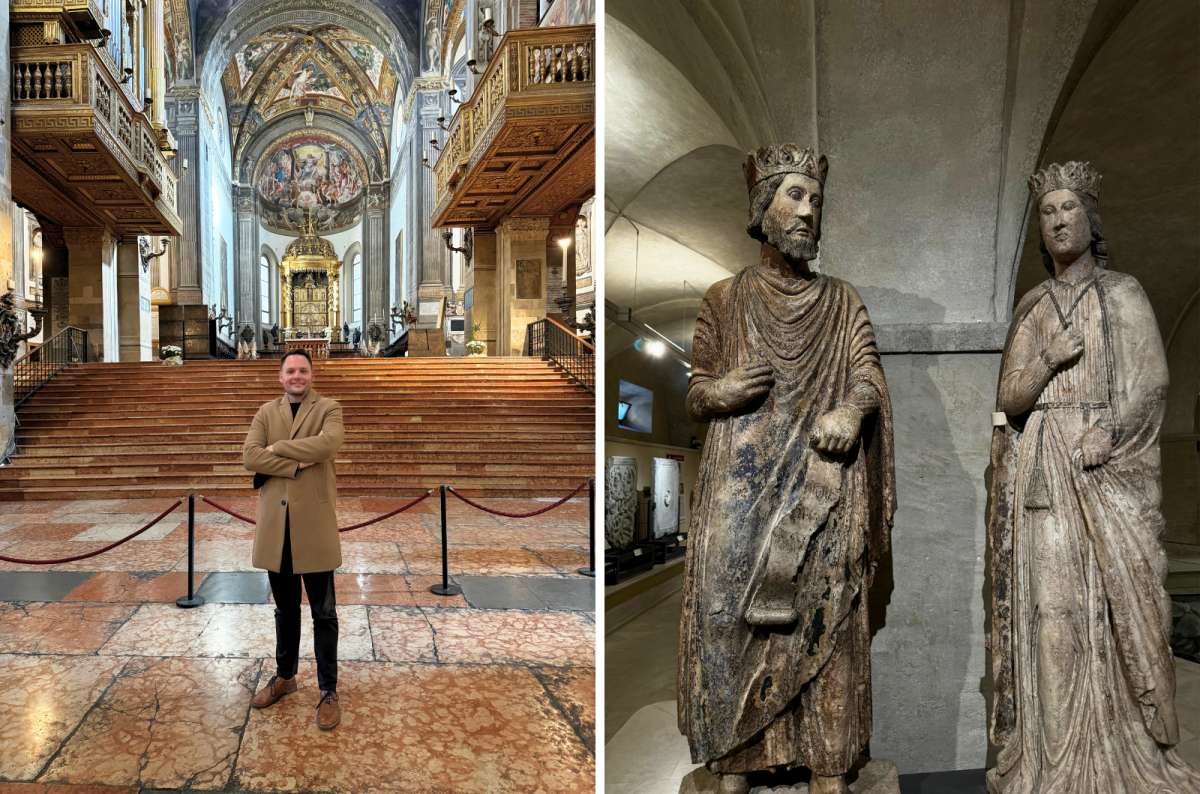
Parma Cathedral’s fantastically frescoed interior and medieval statues from the Baptistery Museum
Afternoon: The best museums in Parma
After some food and drinks, we decided to head to the admittedly creepy Castello dei Burattini (free). The museum is based on the work of the Ferrari family (no relation to the car brand, just a fun name coincidence), who were masters of traditional Italian puppetry. I think puppets are always more nightmarish when they move, so try to catch a show if you can.
Appreciate Emilia Romagna’s cuisine at the pasta and tomato museums in Parma
Now it’s finally time for more of what Emilia Romagna is known for: food! We drove out to the Museum of Pasta and Museum of Tomato (EUR 5 each, open weekends March–December). I feel I need to add a disclosure: it’s Barilla-funded, but surprisingly fascinating, and I learned tons.
Bonus: They’re right next to each other, so you can kill two food groups with one stone.
We wrapped up our day with a cheese-and-meat finale. If you can’t fit in both, choose between the San Pier Damiani Dairy (EUR 25, book ahead, includes tasting) or the Museo del Prosciutto di Parma (EUR 5, tasting EUR 3). One’s run by 7th-generation cheesemakers, the other will have you stuffing ham into your luggage like a criminal. (Or do both. Nobody’s judging. Definitely not me, who found out the hard way that one of the most unexpected things to do in Emilia Romagna is buying an extra bag to fit all the cheese and ham into.)
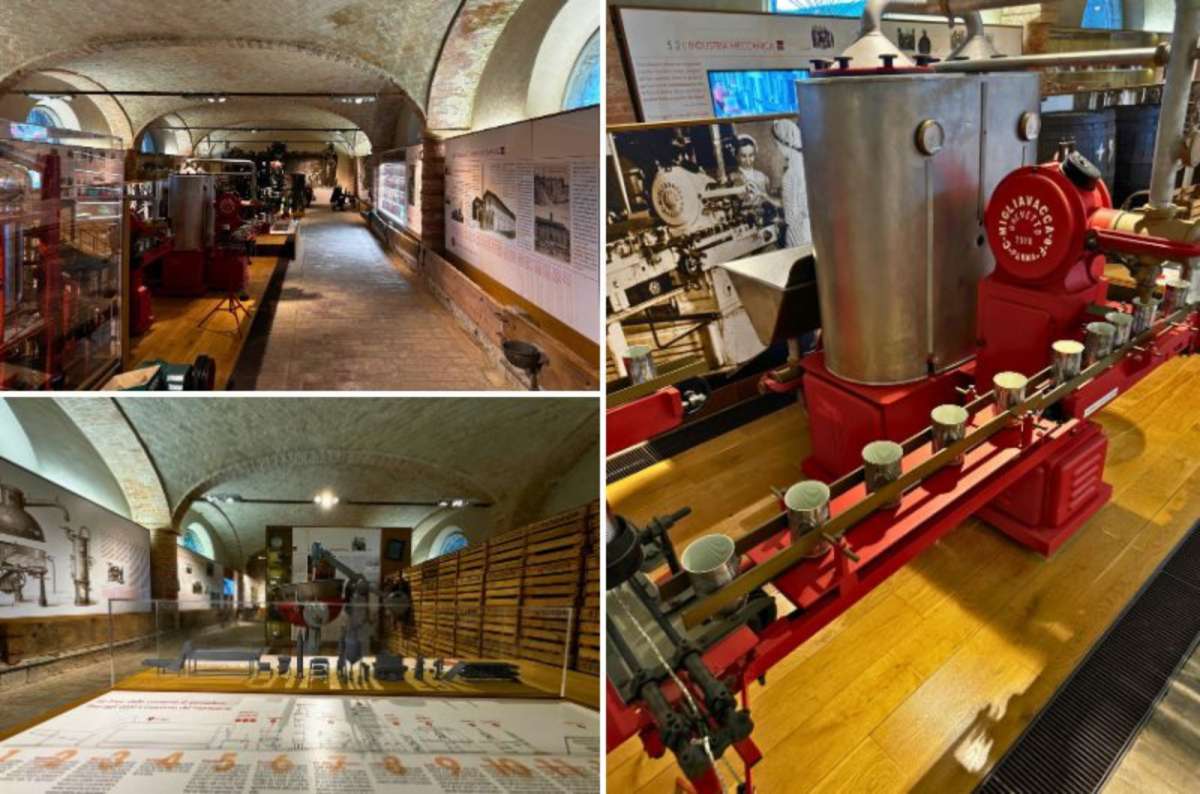
Yes, there’s a Museum of Pasta in Parma—and yes, it’s way cooler than it sounds
Dinner in Parma—do not skip
Right now, I know you’ll be just about ready to head back to Modena to be closer to your hotel bed, but resist the urge. You HAVE TO have dinner in Parma at least once on your Emilia Romagna itinerary.
Trust me when I say: make reservations at Trattoria Ai Due Platani—it’s a 5-minute drive from the city center and genuinely one of the best meals I’ve ever had in Italy. You know, Italy—the country where everything tastes amazing? See, I warned you about the stretchy pants.
Drive back to Modena for the night.
Pro travel tips for Parma
-
Park at Parcheggio Toschi—it’s central and cheap.
-
November = truffle season, fewer tourists, and perfect eating weather.
-
Coperto fees are everywhere—you pay for the table, not the food. And no, you can't skip it by pretending not to eat the bread.
Day 4 of Emilia Romagna itinerary: Hiking Pietra di Bismantova
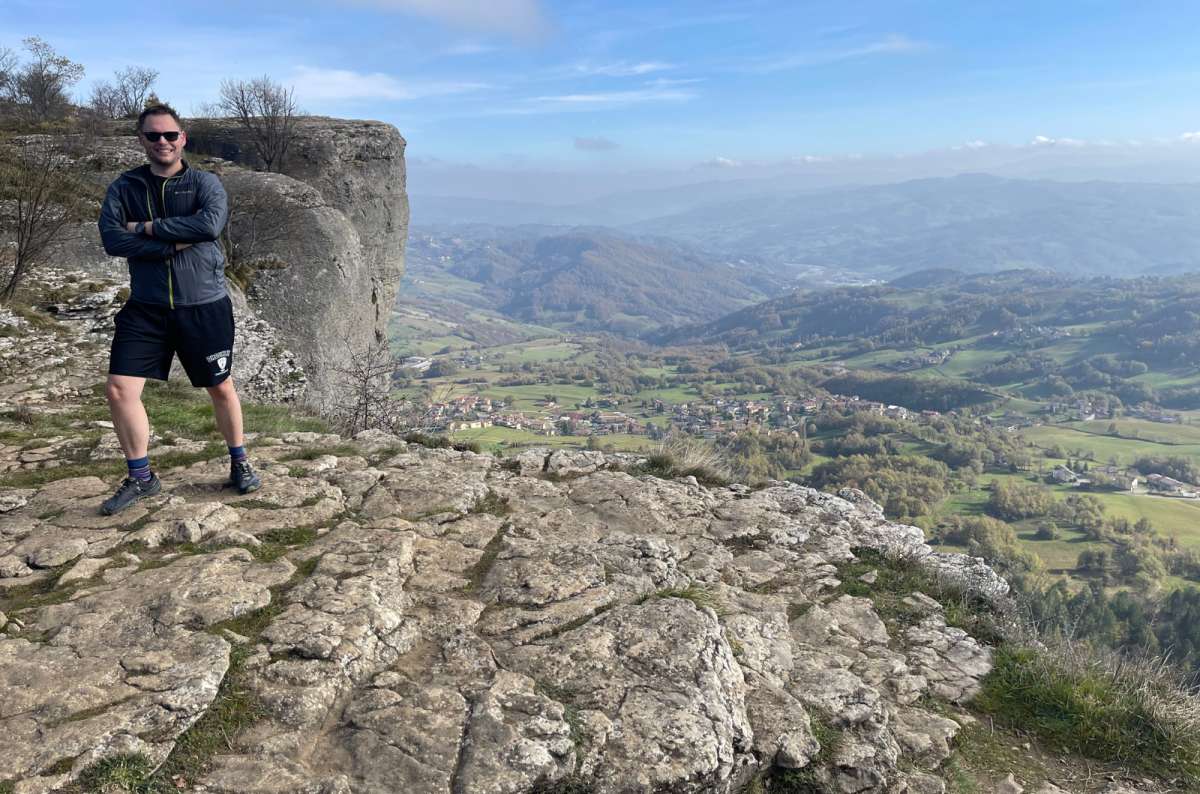
Hiking in Emilia Romagna: think of it as a way to earn all those carbs you’re eating!
Hike stats:
- Hike length: 4.5 km (2.8 mi) loop (but you can also just take the 300 m up to the summit and call it a day)
- Elevation gain: 100 m (328 ft)
- Difficulty level: Easy to slightly moderate
- Hiking time: 1.5 hours
After all the food and frescoes (and before more food and frescoes), I needed to stretch my legs, so I headed into the Apennines for a short hike at Pietra di Bismantova—a giant sandstone slab rising out of the earth.
It’s perfect if you’re looking for hiking in Emilia Romagna that doesn’t put your legs out of order for the next two days.
Getting to the trailhead
The hike starts from a big parking lot (Piazzale Dante in Google Maps) just above the closest town, Castelnovo ne’ Monti, which is a little over an hour’s drive from Modena. The signage is clear, and the views start long before you get there.
You can either hike up the regular trail, or there’s a via ferrata. I stuck to the basic path—just 300 m (980 ft) to the top with maybe 100 m (325 ft) elevation gain. You then continue with the full loop around the formation, which is about 4.5 km (2.8 mi) and takes roughly 1.5 hours.
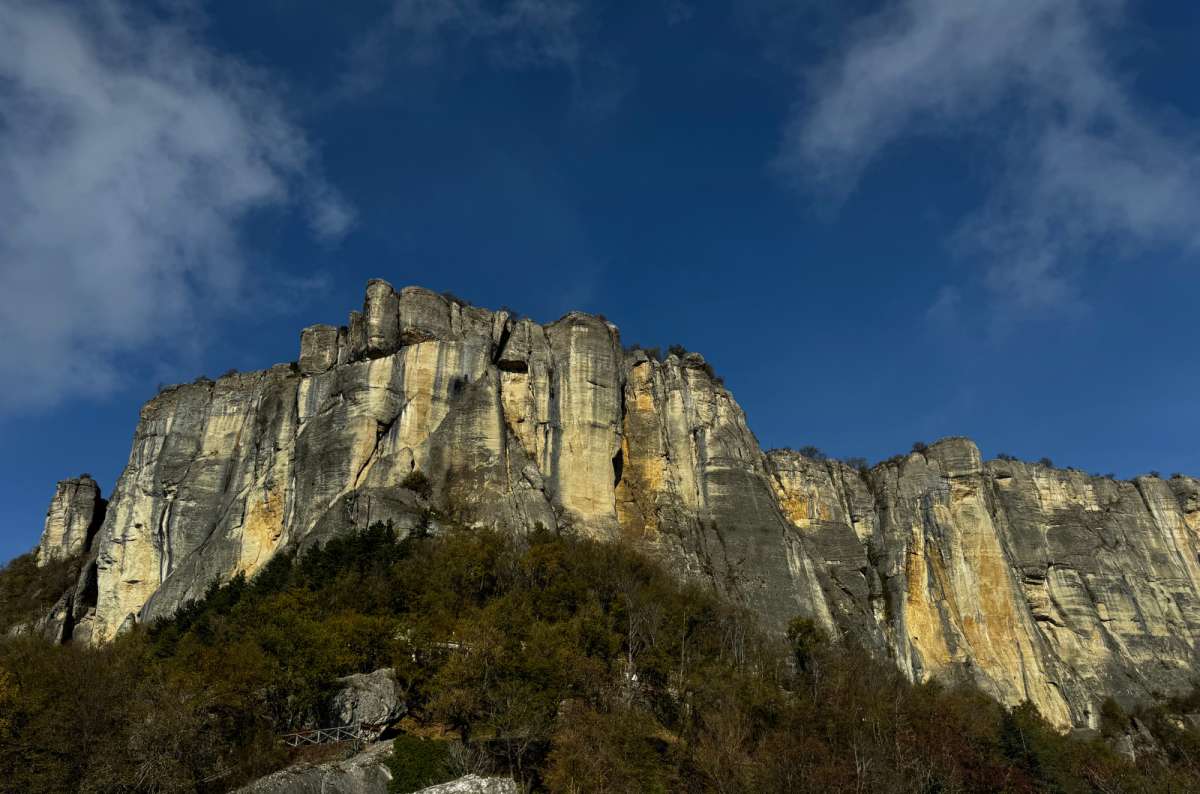
Pietra di Bismantova’s cliffs—Emilia Romagna’s natural skyscraper
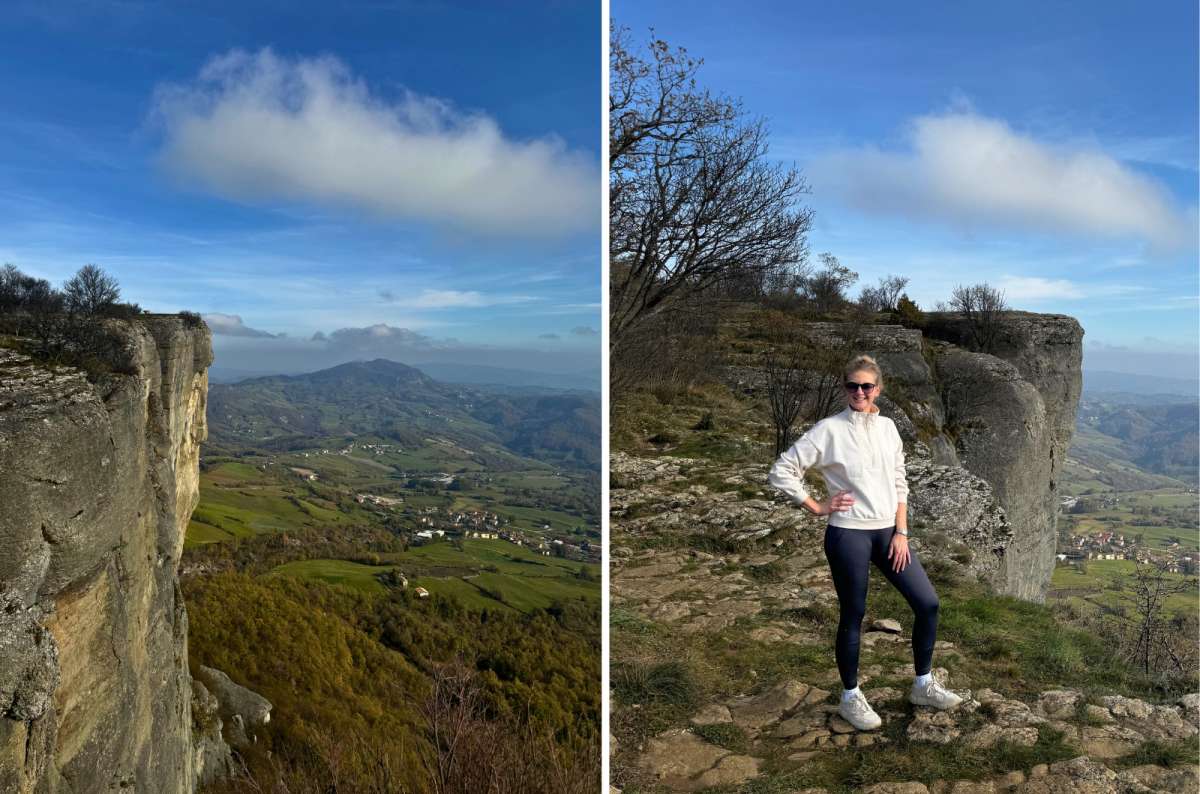
This was taken in November, when the weather in Emilia Romagna is perfect for hiking
My experience on the Pietra di Bismantova hike
The views from both the top and the parking area are wild—360 degrees over the surrounding countryside. It’s incredible. The summit is a flat panoramic space that honestly reminded me of Table Mountain in Cape Town.
There are a few mountain huts along the trail and some geological signs at the beginning that show how the entire Italian peninsula looked during the last Ice Age—way cooler than I expected.
You’ll also pass the ruins of an ancient fortress—Castello della Pietra di Bismantova. There’s not much left, but you’ll find signs near the summit pointing out where the castle once stood and explaining its long, strategic history.
After this, it’s back to Modena to rest up before diving into Bologna.
Day 5 of Emilia Romagna itinerary: Day Trip to Bologna
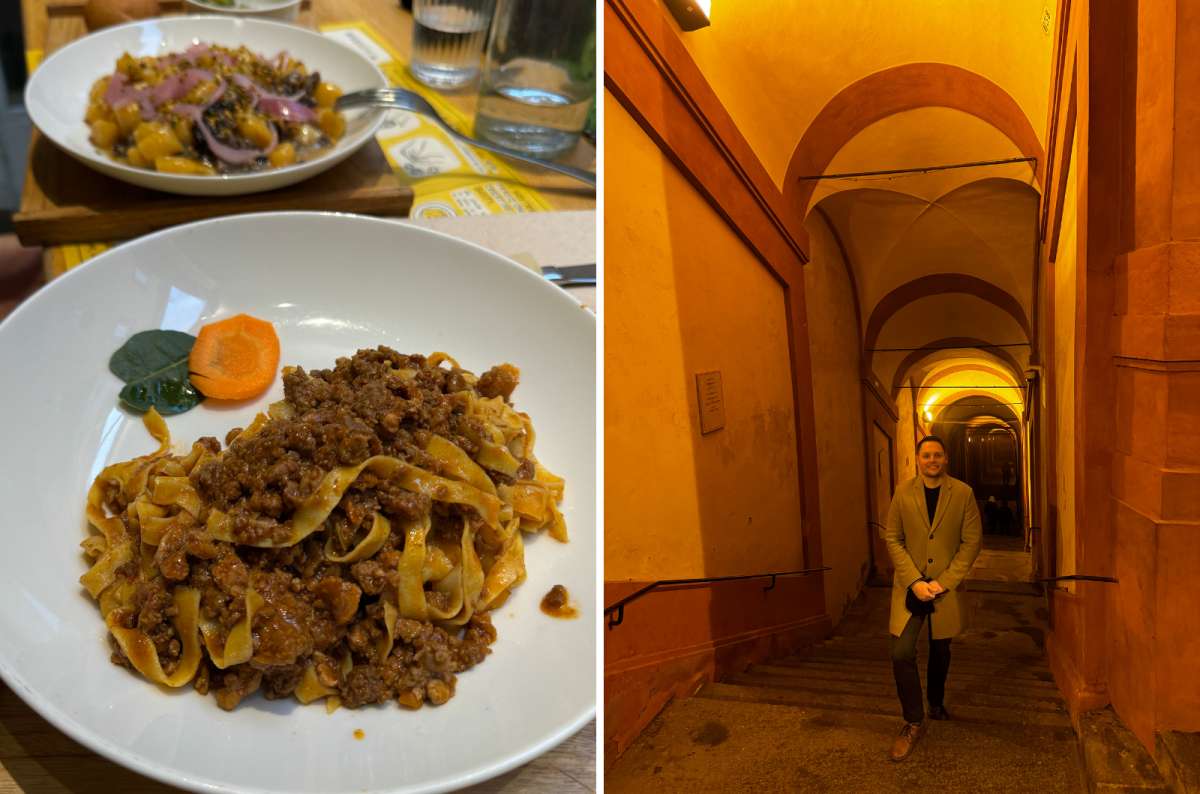
Classic ragù and an iconic portico in Bologna
Main sites visited:
- Portico of San Luca (free)
- Piazza Maggiore (free)
- Basilica di San Petronio (Free entry)
- Two Towers (view only; climbing currently closed because the towers are shifting)
- Anatomical Theater of the Archiginnasio (EUR 3)
- Museum of Palazzo Poggi (EUR 7)
- Pinacoteca Nazionale di Bologna (EUR 12)
- Basilica di Santo Stefano (Free)
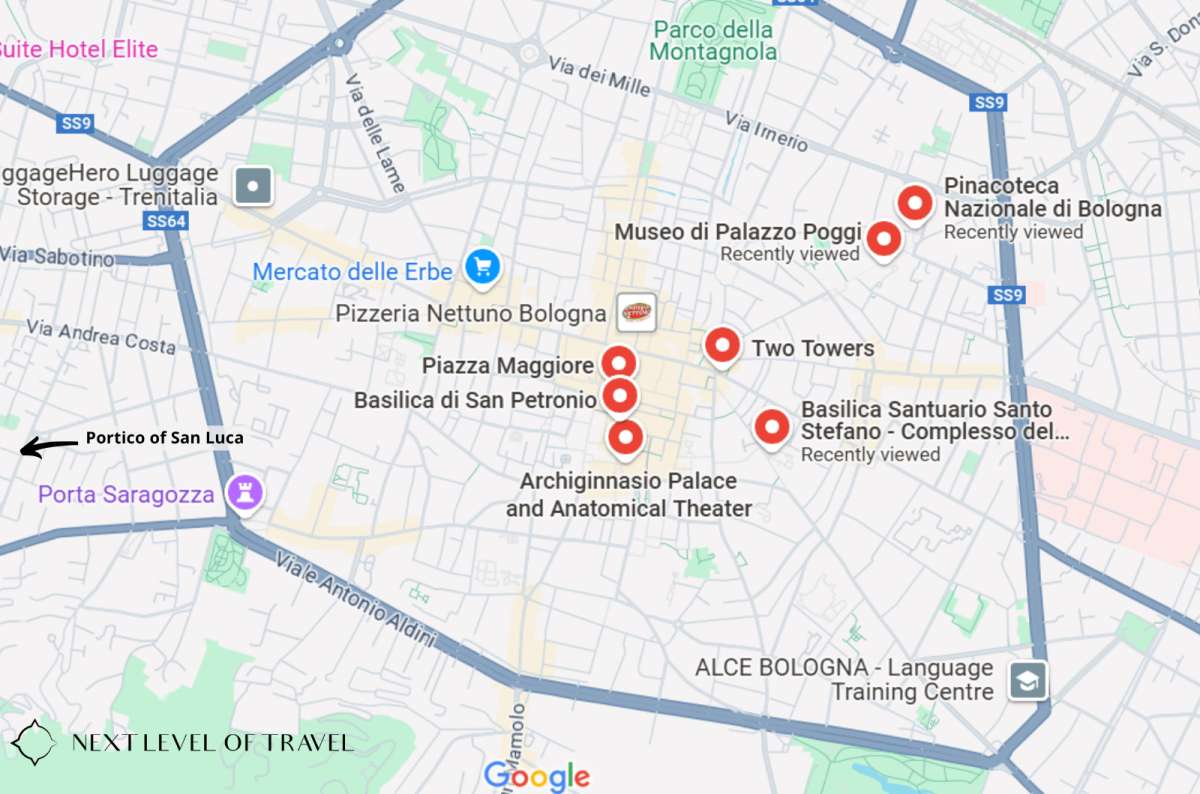
Day 5 of the Emilia-Romagna itinerary: Discovering Bologna’s historic center, iconic towers, anatomical theater, and the Portico of San Luca
Restaurant tips:
- Sfoglia Rina – Famous for rabbit tortelli and tagliatelle Bolognese
Hotel recommendations:
Further reading:
Another day, another day trip. Today, you’re heading to Bologna! It’s the capital of the region, the most walkable of all Emilia Romagna cities, and it doesn’t hold back when it comes to food, architecture, or attitude.
Logistics tip: Pack your bags, because tonight you’ll be sleeping at a different hotel closer to your last 2 destinations on this Emilia Romagna trip plan. It doesn’t make sense logistically to go back to Modena and then drive all the way to the coast in the morning.
Morning: Walk (or drive up) to the best viewpoint in Bologna
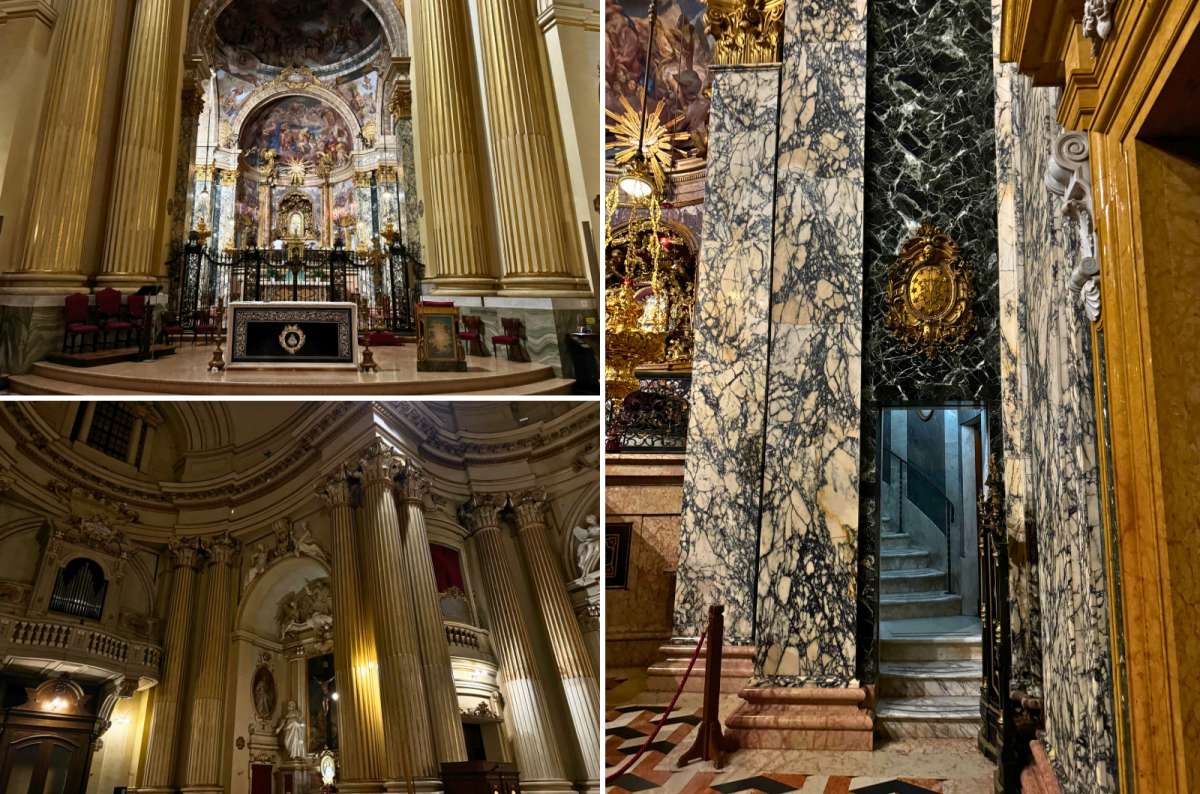
Inside Sanctuary of the Madonna di San Luca: golden columns, hidden staircases, and serious drama
Start the day with one of the most interesting things to see in Emilia Romagna, the Portico di San Luca, the world’s longest covered walkway. It’s 3.5 km of arches climbing uphill like a religious treadmill to the Sanctuary of the Madonna di San Luca.
For a full-on spiritual awakening, it may have been a good idea to hike it, but we drove right to the top. You gotta pick your battles, you know? You can still appreciate the 600+ arches from the road as you drive along the walkway.
The basilica itself is really impressive too, and the views from the top are worth the trip. We saw it at sunset, and it was pretty darn cool.
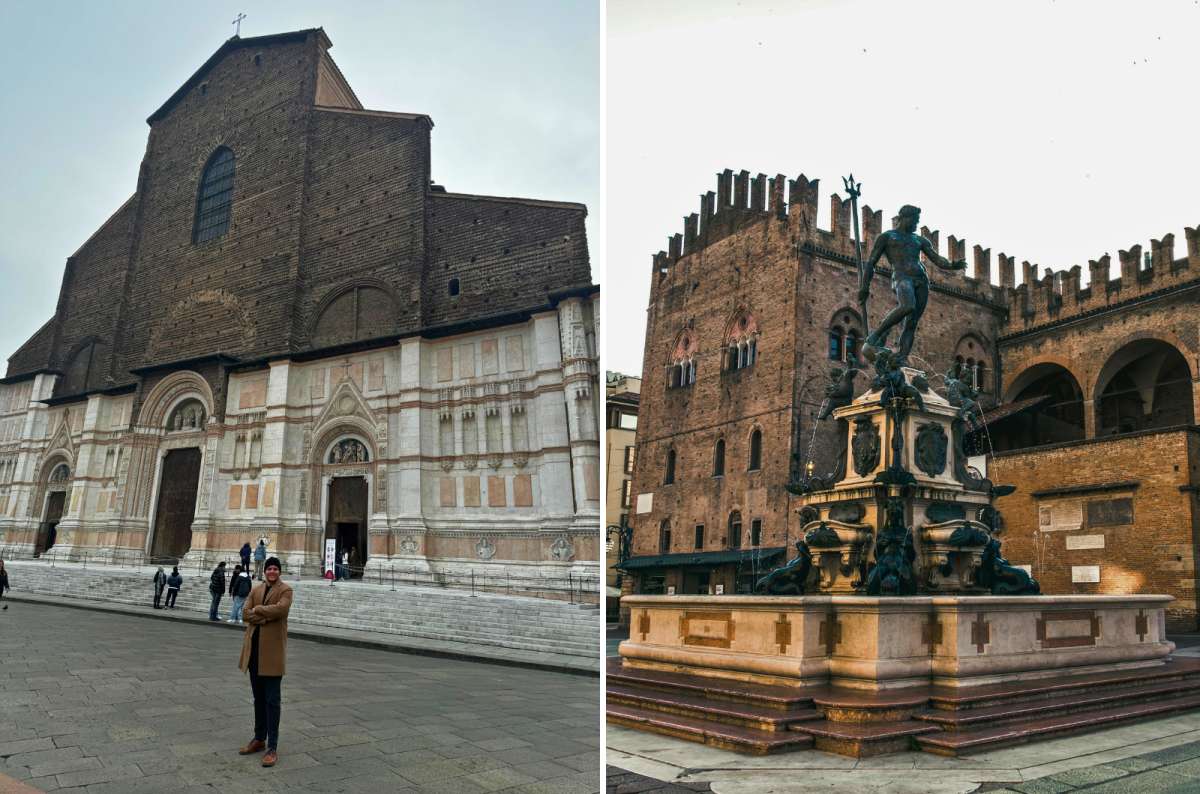
The half-and-half Basilica di San Pietro on the left and Neptune on the right
Back in Bologna’s historical center
Back in town, head straight to Piazza Maggiore, Bologna’s main square, where I instantly noticed Basilica di San Petronio with its half-marble, half-brick “maybe we’ll finish it someday” vibe.
Just a few steps away, on a smaller square, I couldn’t help but feel that Neptune’s Fountain is more amusing than majestic. But the photo of Neptune flexing with Palazzo Re Enzo looming behind is mandatory.
Then I walked 5 minutes over to the Two Towers. Torre degli Asinelli is the tallest leaning tower in Italy (surprised it’s not the one in Pisa?)–a clear contender for your “interesting attractions in Emilia Romagna” checklist. Well, it turns out they're closed for visitors now because they shifted a little too much for comfort in 2023. Still, you’ll want to snap that photo now before one of them finally gives up and topples over.
Afternoon: some unusual things to do in Emilia Romagna
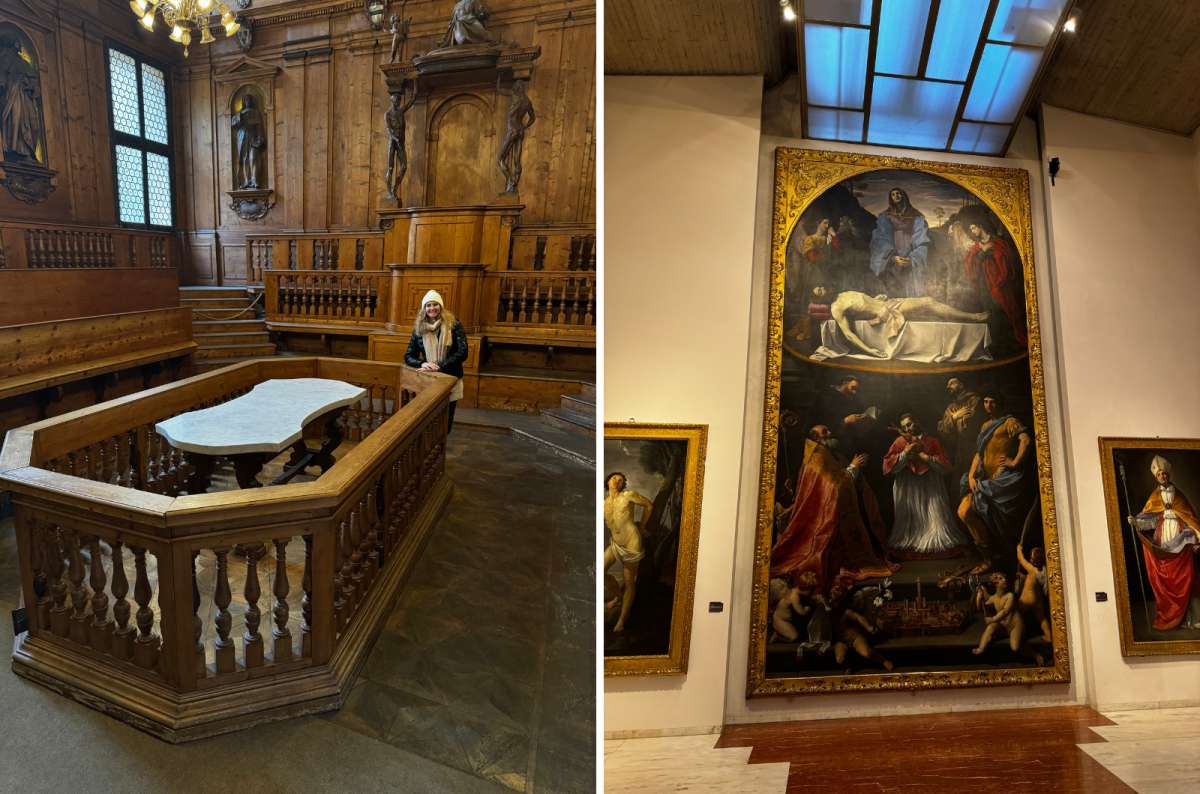
Anatomy and art—Bologna’s museums deliver brains and beauty (kind of like me)
Sfoglia Rina for lunch is non-negotiable. The rabbit tortelli and tagliatelle with ragù were divine. It’s the best meal we've had in Bologna. Bonus: no coperto charge!

Next, we head to the Anatomical Theater of the Archiginnasio. It’s small, slightly creepy, and fascinating—like Hogwarts if it focused on slicing cadavers. Keeping with the theme, this next one is another unusual thing to do in Emilia Romagna’s Bologna: the Museum of Palazzo Poggi. Fetuses in jars, botched taxidermy, 16th-century fort-building strategies—definitely not kid-friendly, but unforgettable.
Visiting the best art gallery in Emilia Romagna, Pinacoteca Nazionale
Then we went from weird to full culture mode at the Pinacoteca Nazionale, Bologna’s national art gallery. I strongly urge you to visit even if you’re not super into art. Take an hour inside the 30 rooms, and I promise at least a few of the masterpieces will catch your attention. There are dramatic frescoes ripped from church walls and the works of Lavinia Fontana, a Baroque girl boss and one of the first female painters to make it big.
Before heading to your new hotel, end your trip to Bologna at the Basilica di Santo Stefano, a peaceful cluster of seven ancient churches all huddled together. It’s refreshingly untouristy and deserves a spot on your Emilia Romagna itinerary.
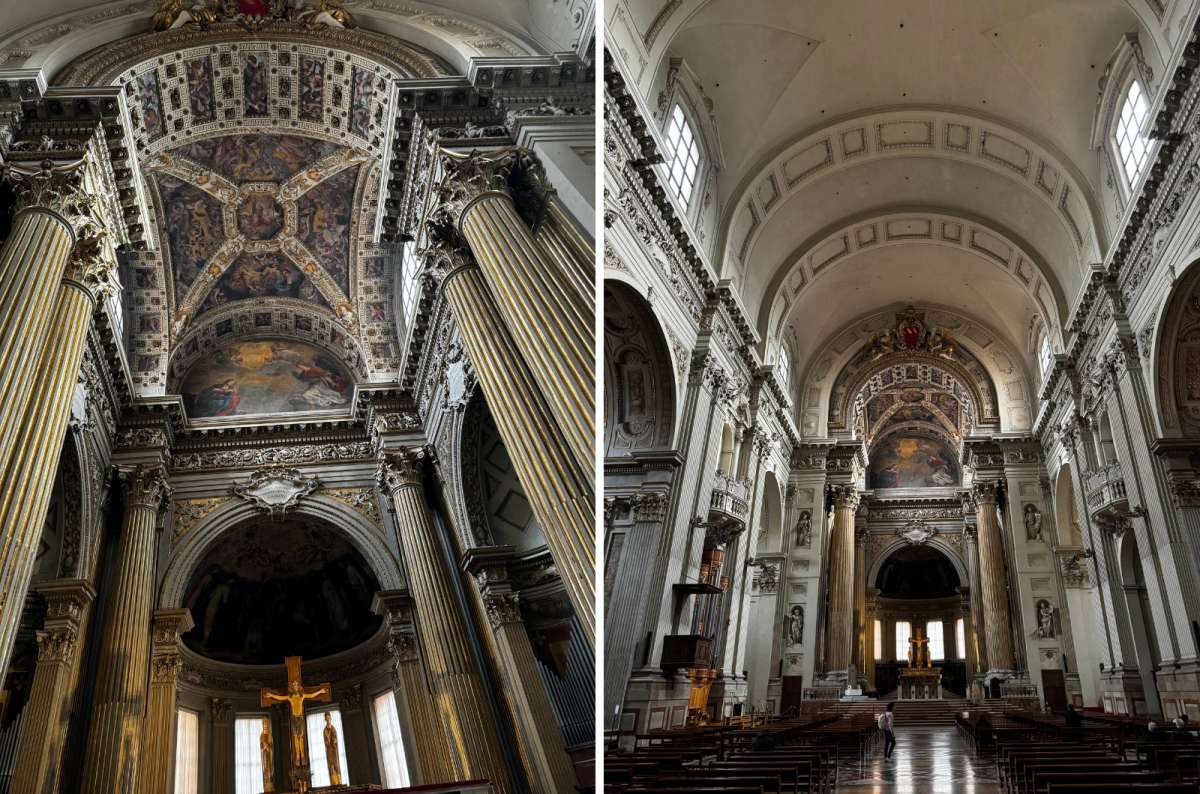
Inside Bologna’s Basilica Santuario Santo Stefano
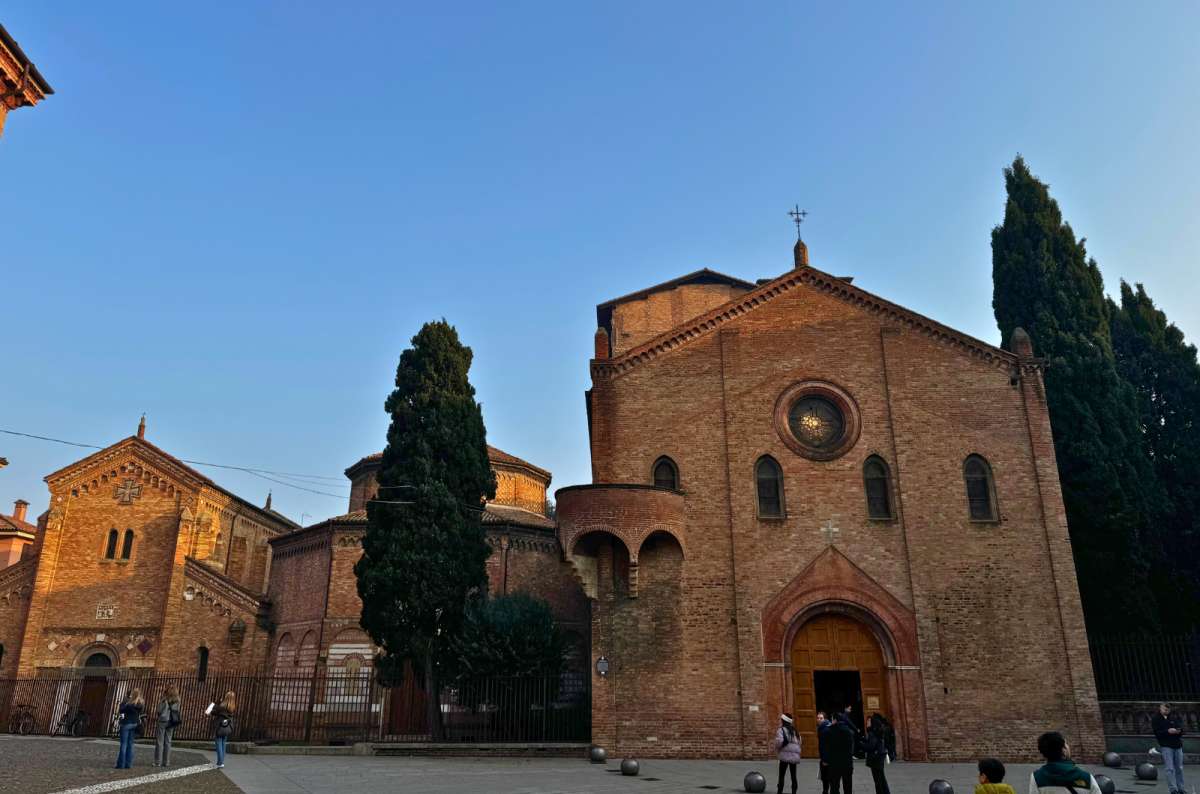
Santo Stefano is actually seven churches in one, built to echo Jerusalem’s holy sites
Switch hotels: Driving from Bologna to Relais Villa Margherita (in Longiano)
After 4–5 nights based in Modena, it’s time to change things up. Head east and check into Relais Villa Margherita, just outside Ravenna and San Marino, for the final days of your 7-day Emilia Romagna itinerary. I loved this stunning hotel SO much, despite it being slightly on the expensive side.
The hotel is located in Longiano, about 90 km (55 miles) southeast of Bologna. Driving takes about an hour on a scenic highway.
Pro travel tips for Bologna
-
Start with the Portico di San Luca in the morning—either walk or drive, but don’t hike in midday heat.
-
Dress codes matter—Shoulders and knees covered in holy houses, folks. Church rules still apply even if you’re on vacation in Emilia Romagna—God is still watching.
-
Visit Santo Stefano late afternoon for moody light and fewer crowds—it’s one of Bologna’s most atmospheric spots and feels even better in silence.
Day 6 of Emilia Romagna itinerary: Ravenna Day Trip: the best UNESCO mosaics
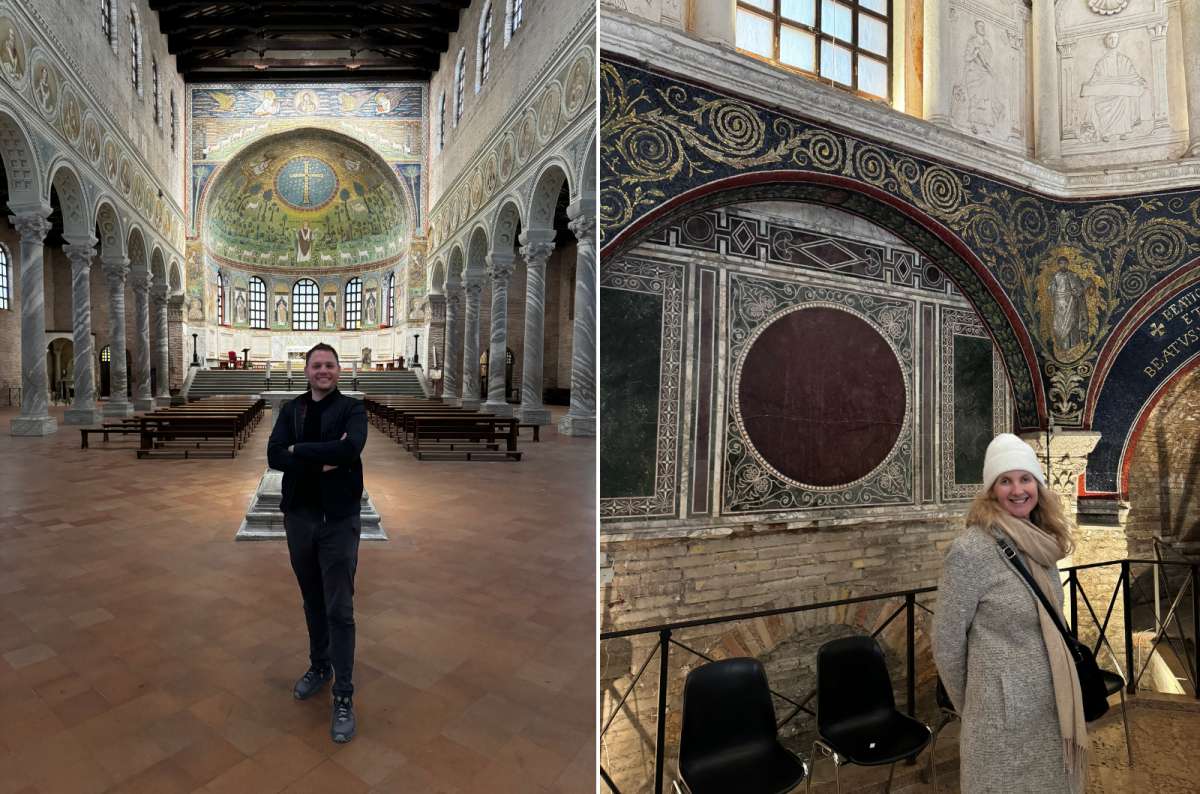
Just some of Ravenna’s 1,500-year-old mosaics, no biggie, @ Sant'Apollinare in Classe
Main sites visited:
- Classis Ravenna Museum (EUR 12.50 combo ticket)
- Basilica of Sant’Apollinare in Classe (combo ticket)
- Mausoleum of Theodoric (combo ticket)
- Basilica of San Vitale (combo ticket)
- Mausoleum of Galla Placidia (combo ticket)
- Domus of the Stone Carpets (EUR combo)
- Neonian Baptistery (combo ticket)
- Archiepiscopal Chapel (combo ticket)
- Basilica of San Francesco & Dante’s Tomb (combo ticket)
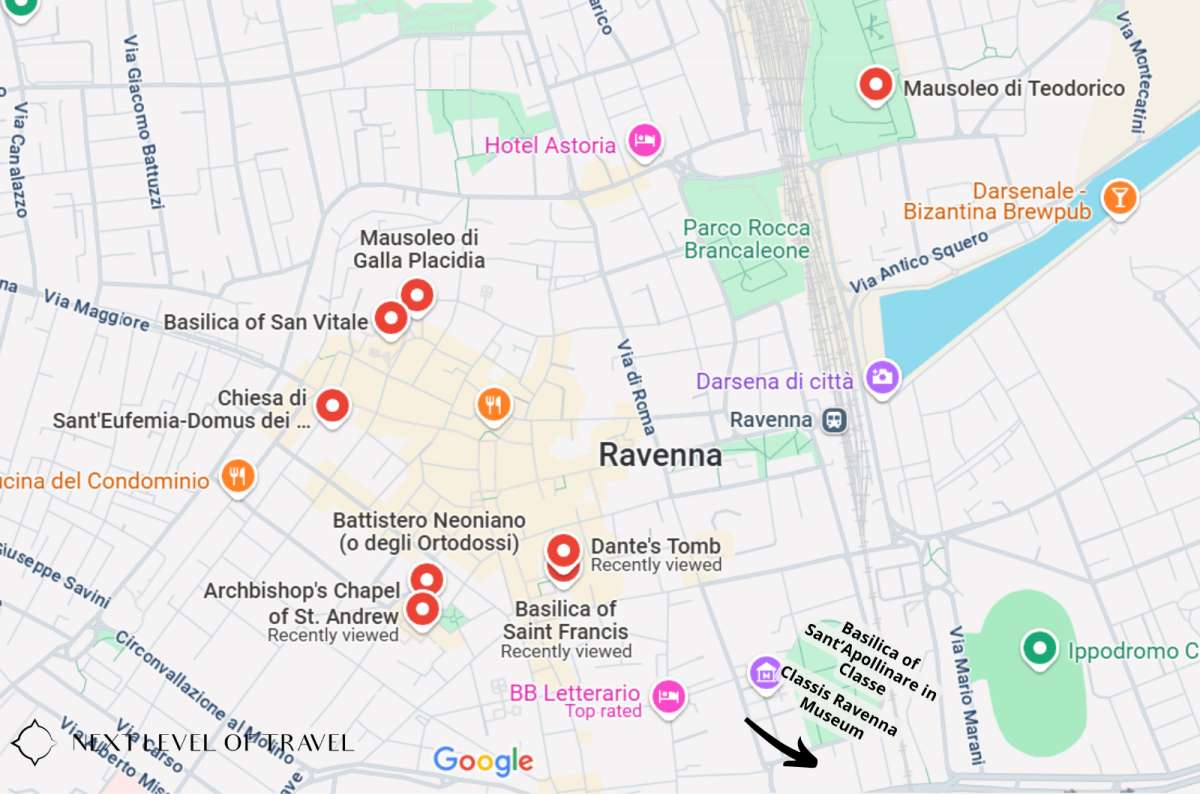
Map showing Ravenna’s famous mosaics, early Christian monuments, and Dante’s Tomb
Restaurant tips:
- La Terrazza—I literally had a golden egg here
Hotel recommendations:
Further reading:
You have to visit Ravenna during your week in Emilia Romagna if you have even an ounce of appreciation for ancient empires, timeless mosaics, or the fact that Ravenna has eight UNESCO World Heritage Sites.
I’ve been to Ravenna on three separate trips now, so you can tell I really think it’s worth visiting. I am very much into history though, but if you are not, one day will definitely be enough. Here’s what I think are the highlights that anyone will appreciate:
Morning in Ravenna: Emilia Romagna’s historical treasure
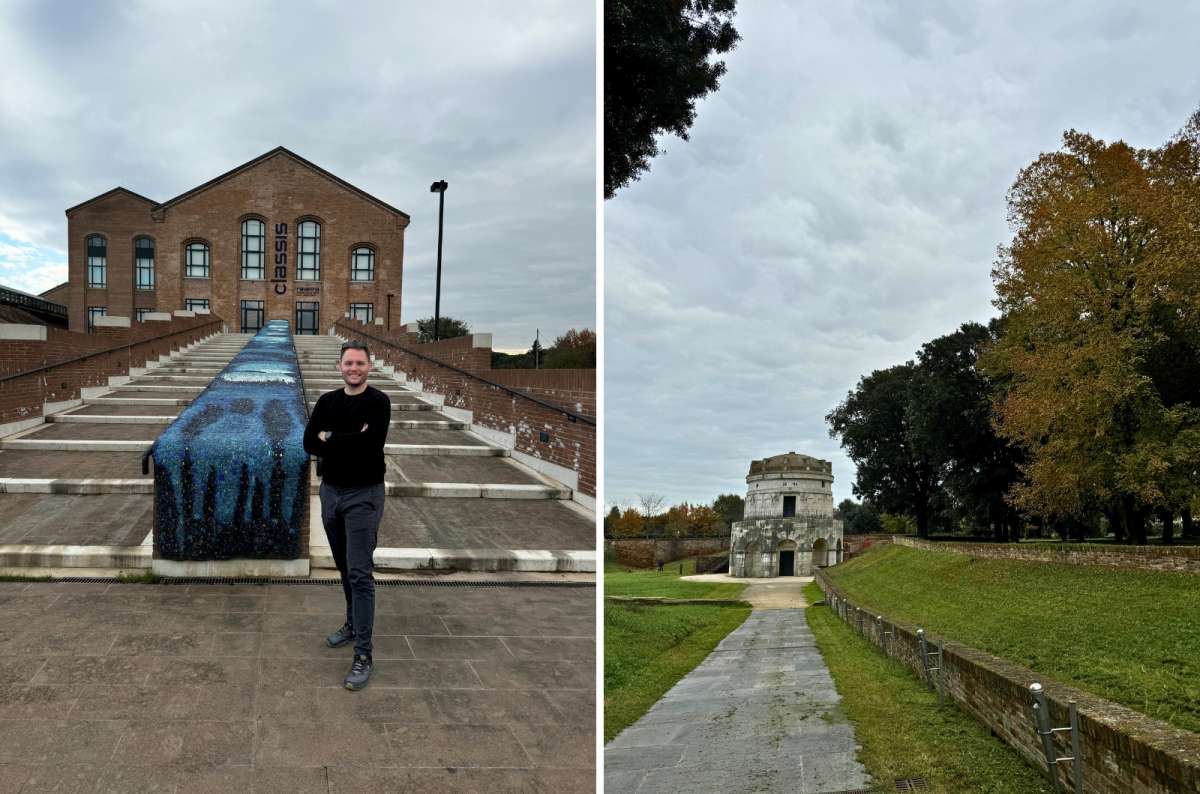
Starting @ Classis Ravenna
Start by visiting these museums just outside of Ravenna
Start at Classis Ravenna (EUR 7). It’s just outside the city (but it’s close to the next stop, so no worries about wasting precious time), in a repurposed sugar factory that itself looks really cool. I found it great to start the day learning how Ravenna went from a Roman port to a full-on Byzantine cultural powerhouse. Everything I saw after that made more sense.
From the museum, head to the Basilica of Sant’Apollinare in Classe (EUR 5). It’s a short drive, maybe 10 minutes, and easily one of the top churches in Emilia Romagna. Massive interior, giant apse mosaic, and a special shout-out to the giant image of Apollinare surrounded by sheep. It’s weirdly great.
Continue to the Ravenna city center and get blown away by San Vitale
After that, drive into Ravenna and visit the Mausoleum of Theodoric (EUR 4). No mosaics here, which is actually a nice break. It’s this bare stone structure with a bizarre lightning-proof roof.
I recommend wrapping up the morning with the main highlights of Ravenna: Basilica of San Vitale and Mausoleum of Galla Placidia (combo ticket EUR 12.50). San Vitale blew me away. The mosaics are just on another level. Galla Placidia’s mausoleum is tiny, but you’d never guess from the outside that the inside is a cosmic trip—one of the more unexpectedly delightful places to visit in Emilia Romagna.
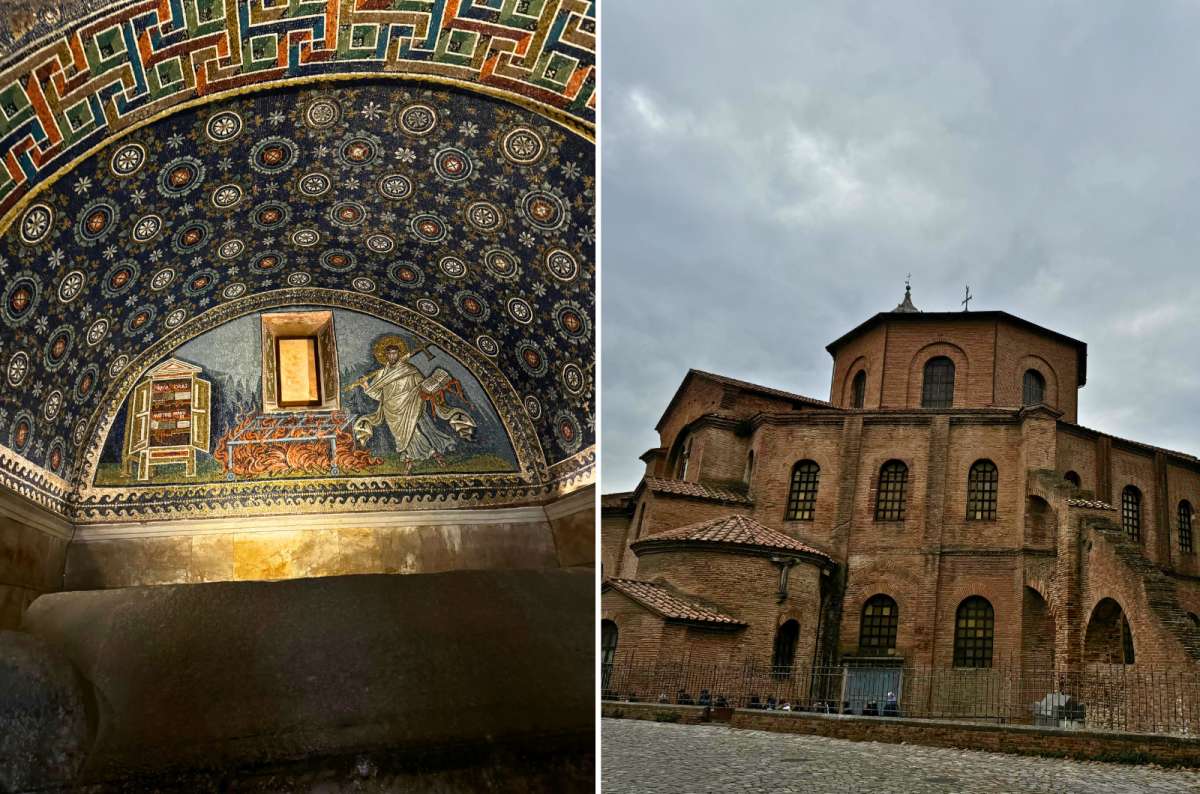
The Mausoleum of Galla Placidia with its 5th-century mosaics
Afternoon in Ravenna: Finding more incredible UNESCO mosaics

From gladiator mosaics beneath your feet to gold-flecked biblical arches above
Now onto the Domus of the Stone Carpets (EUR 4), an underground Roman villa with more mosaics, because why not. You should understand by now that seeing mosaics is one of the best things to do in Emilia Romagna. So, more is more.
Next, you’ll want to speed-tour the Neonian Baptistery and then spend 30–45 minutes exploring the Archiepiscopal Chapel (both in the EUR 12.50 combo)—the mosaics at both mesmerized me. I’m serious, I almost couldn’t leave the chapel, and not just because my neck started cramping.
Visit Dante’s Tomb for free
Then head to the Basilica of San Francesco and Dante’s Tomb (both free). The crypt has literal fish swimming under the altar. If that doesn’t intrigue you, maybe Dante’s tomb next door will.
Finally, say goodbye to Ravenna at the Basilica of Sant’Apollinare Nuovo. The colors are more muted in this one, but they still wowed me.

This 6th-century mosaic in Ravenna once honored a king—until monks edited him out with curtains. Add this one to your hilarious things to see in Emilia Romagna list @ Basilica of Sant'Apollinare Nuovo
Pro travel tips for Ravenna
-
Don’t overplan the walking. Ravenna is almost too walkable—everything is within 20 minutes.
-
Use the EasyPark app for parking. Unlike Florence or Bologna, parking here won’t require black-market kidneys.
-
Avoid peak summer. Visit in November instead—fewer people, better food (mushroom and truffle season, anyone?), and the weather won’t melt you.
-
Ravenna Cathedral is skippable. If you’re tight on time, you won’t lose sleep skipping this “meh” baroque latecomer.
Day 7 of Emilia Romagna itinerary: San Marino and Italy in Miniature

San Marino views and Guaita Tower
Main sites visited:
- Italy in Miniature (EUR 19 + EUR 4 parking)
- San Marino’s Guaita, Cesta & Montale Towers + Palazzo Pubblico (EUR 11 combined)
- Basilica di San Marino (Free)
- San Marino Cable Car (EUR 3, EUR 10 for unlimited rides)
- Optional: San Marino Outlet Experience (tax-free shopping)
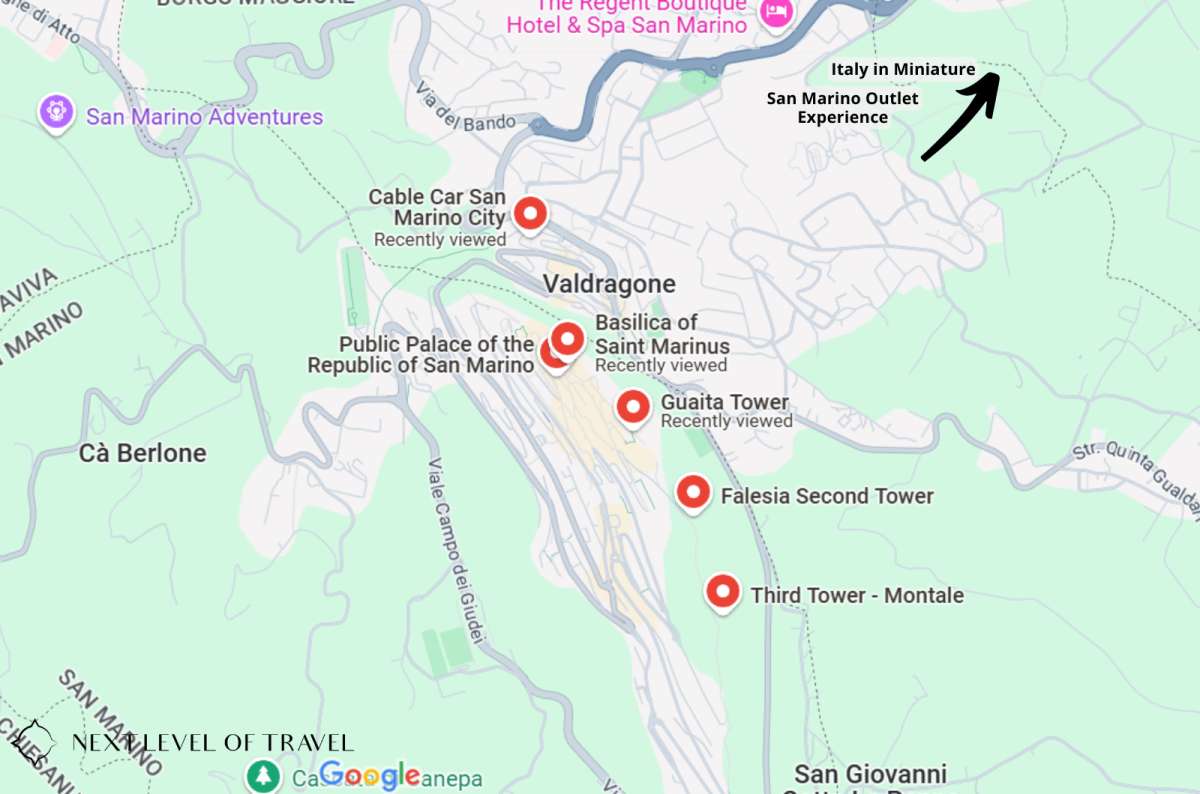
Last day of the Emilia-Romagna itinerary: Visiting Italy in Miniature and San Marino’s historic towers
Restaurant tips:
- La Terrazza – Dinner spot with hilltop views in San Marino City
Hotel recommendations:
Further reading:
Forget just seeing one of Italy’s regions—you’ll tour all of Italy on last day on your Emilia Romagna itinerary! And you’ll even leave the country!
Start with Italy in Miniature, which is exactly what it sounds like (+ tons of fun), then move on to San Marino, the world’s oldest republic, perched on a cliff with views all the way out to Tuscany. Can you think of a better way to end your trip?
Morning: Italy in Miniature

Italy in Miniature: the fun is full-sized, and you can visit Rome, Verona, and Mount Vesuvius by noon
Italy in Miniature (EUR 19 entry, EUR 4 parking) is a unique thing to do in Emilia Romagna that I lucked out into being able to visit (in November, they were only open for a single day—the day I was able to go).
After a week of adult, historical, and church-heavy sightseeing, you’ll appreciate the novelty—traveling with a kid in tow is not a requirement. You'll see 270 Italian landmarks, and the park itself is shaped like Italy—genius!
The best attraction in Italy in Miniature is the tiny gondolas
Mini Venice is the most popular attraction: you actually ride a tiny gondola through scaled-down canals. I know the whole thing sounds silly, but I was grinning like a six-year-old on a school trip the entire time.
Set aside an hour or so to see the park.
Pro tip: Italy in Miniature opens erratically, so check italiainminiatura.com before planning your Emilia Romagna itinerary. Best to arrive when doors open in summer, though crowds were nonexistent when we visited in low season.
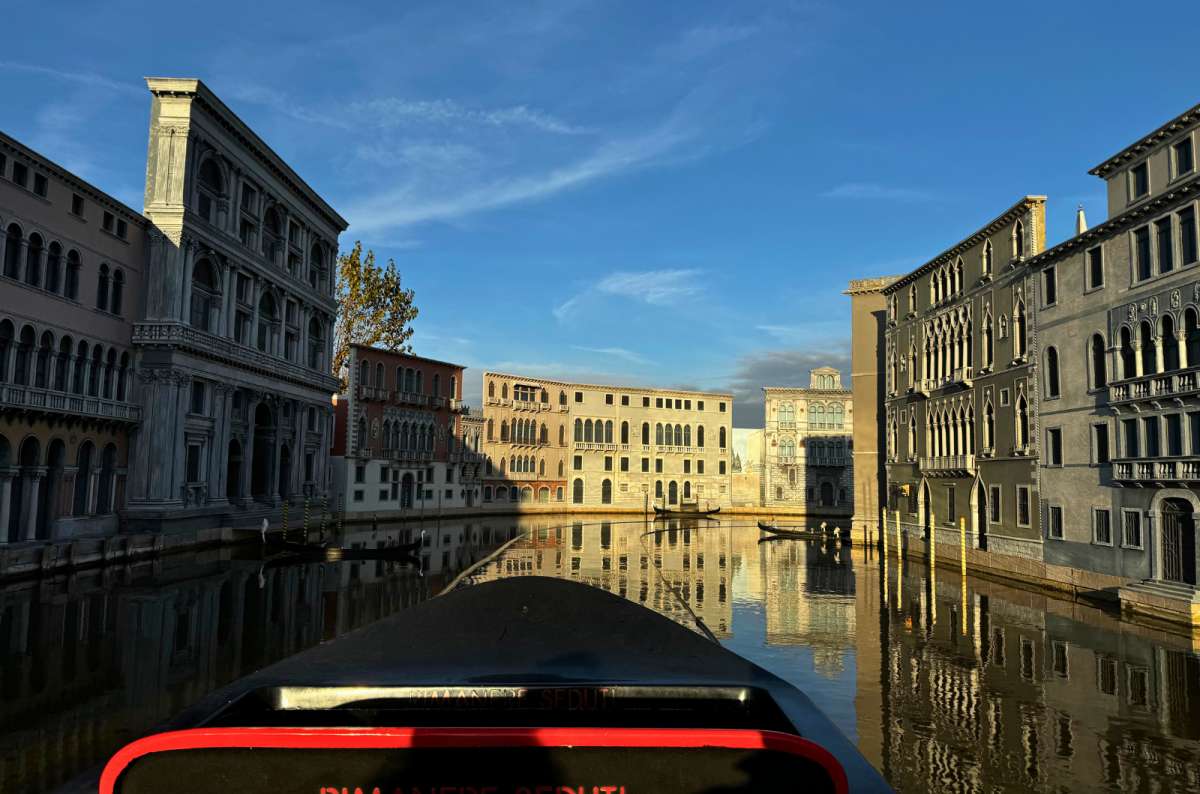
Almost like Venice—just fewer pigeons and smaller gondolas
Driving to San Marino
Then, hop in the car and drive 45 minutes to San Marino, Europe’s third-smallest country. It’s perched on Mount Titano and packed with medieval towers and sweeping views.
Park at Borgo Maggiore and ride the San Marino Cable Car (EUR 3) up to the city—it’s ridiculously scenic.
Afternoon & evening: San Marino half-day trip
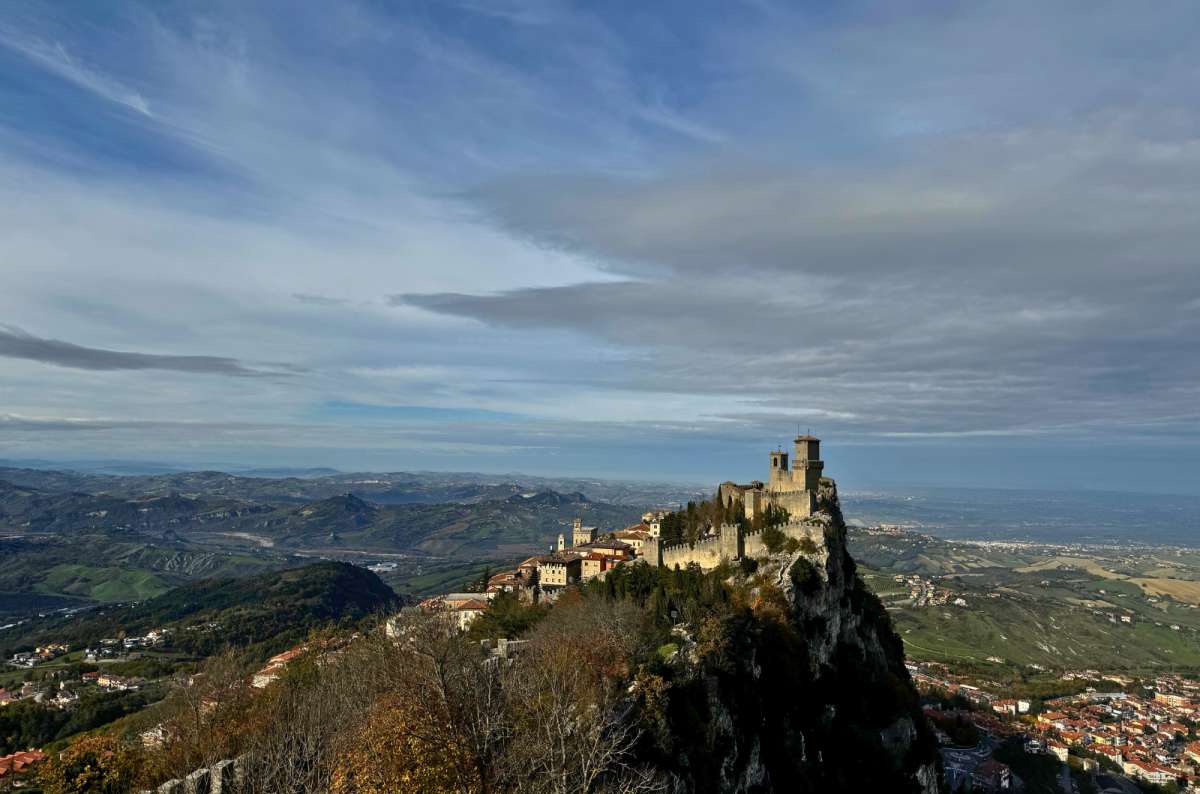
Living my medieval fairytale dreams at the final stop of my Emilia Romagna itinerary, San Marino
Check out San Marino’s towers
Start your day trip to San Marino at Guaita, the most dramatic of the Three Towers. Then follow the path to Cesta, the second tower, which offers the best views back toward Guaita—and doubles as a weapons museum that surprised me with its cool medieval armor.
If you’re curious, you can continue to Montale, the Third Tower—but honestly, it’s underwhelming and closed off, so go with low expectations and do NOT put it on your bucket list of Emilia Romagna’s top things to see.
Other places to visit in San Marino
The EUR 11 combo ticket gets you access to all three towers plus Palazzo Pubblico, where the country’s actual parliament still meets. It’s got a sense of ceremony you don’t get in most tourist spots.
Don’t skip the Basilica di San Marino, though after a day in Ravenna, you probably won’t be blown away by the art. At least there’s a saint’s arm in a glass case.
Skip the outlet mall unless you're really after tax-free Prada. Instead, do like we did and hang around for golden hour on the city walls. Sunset in San Marino is one of the most magical things to do in Emilia Romagna day trips.
Your last dinner in Emilia Romagna (will you eat golden eggs?)
The last evening of your Emilia Romagna itinerary deserves a memorable goodbye: how does a golden egg for dinner sound?! La Terrazza’s right in San Marino’s historic center, and it has spectacular views. I had an egg covered in gold and truffles. I don’t know if that’s classy or ridiculous, but it was delicious (and ridiculous). Definitely book ahead if you want one of the window tables.
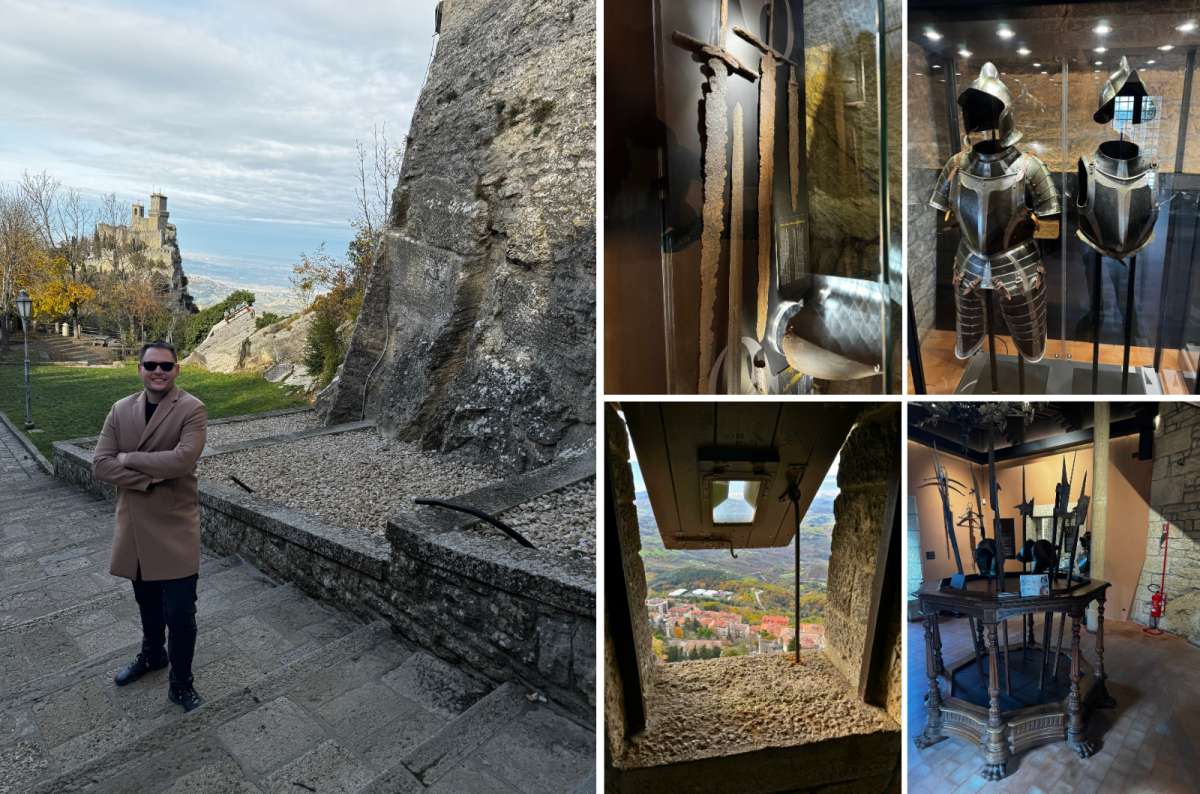
Exploring San Marino’s Towers
Pro travel tips for San Marino
-
Wear real shoes. San Marino is all steep alleys and stone staircases.
-
Get the EUR 11 multi-site ticket. It covers the towers + parliament.
-
Skip the Third Tower if you’re short on time. It's a glorified rock with no access.
-
Book La Terrazza in advance for a sunset table by the window. The view sells out fast.
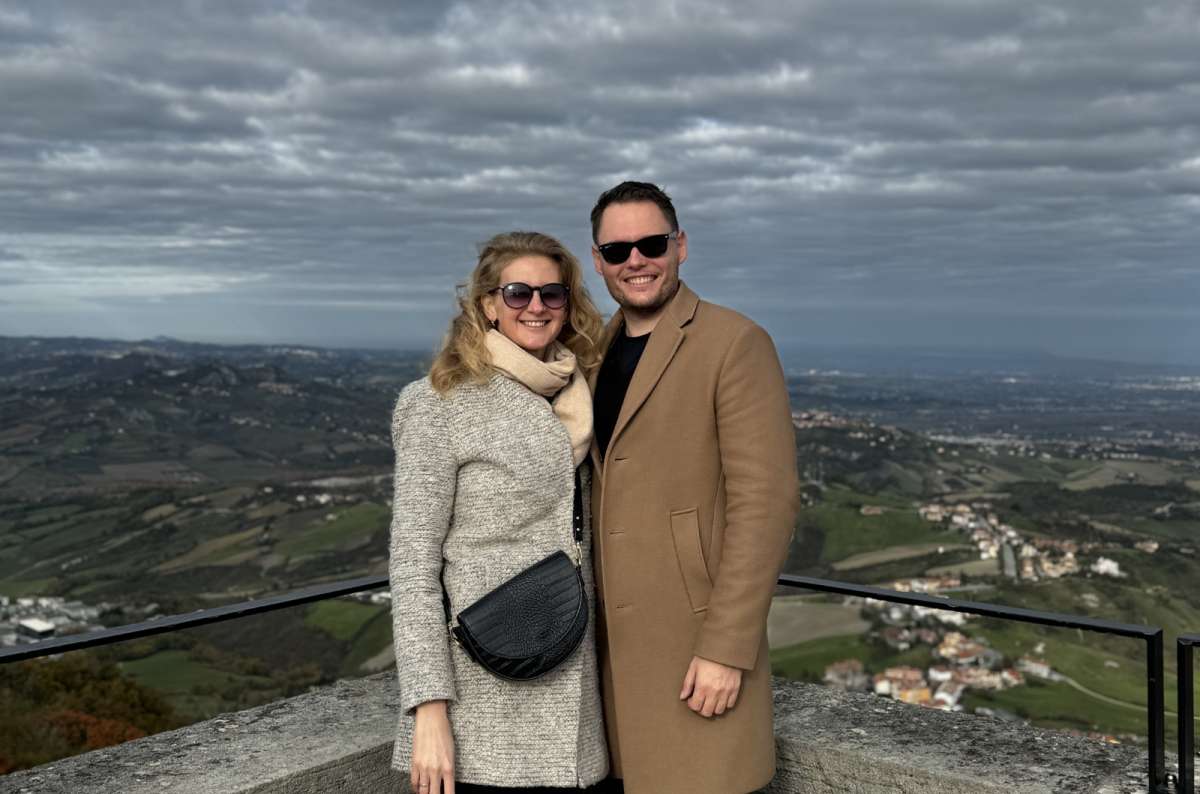
San Marino looking extra scenic from up here
Where to next?
If you’re wrapping up your Emilia Romagna itinerary but not quite done with Italy, you’ve got options. From San Marino, it’s easy to continue with a trip through Tuscany—and I’ve got detailed guides for Florence and Pisa to help you plan the next leg. Make sure to add some underrated gems like Siena and Lucca.
Prefer heading in the other direction? Padua or Venice are waiting for you just a couple of hours north or for a seamless wine-focused add-on anywhere in the country, explore bespoke Italy wine tours.
FAQs
Do you need a car in Emilia Romagna?
Yes. Unless you want to waste time figuring out train schedules and praying buses show up, rent a car. The region is drivable, parking is manageable (especially with the EasyPark app), and it gives you access to harder-to-reach highlights like Pietra di Bismantova or cheese dairies.
Is Modena really the best base?
Yes—and not just because I said so. Modena’s central, packed with things to do, and quieter (and cheaper) than Bologna. Plus, RMH Modena Des Arts was one of my best hotel experiences in Italy.
When’s the best time to go to Emilia Romagna?
Spring and fall are ideal if you want to visit during Emilia Romagna’s best weather. Summer gets hot and crowded. If you want to be totally rebelious, visit in November like I did on my last trip—it’s truffle and mushroom season, and all the best cities in Emilia Romagna are way less touristy.
Sometimes, all you need to do is take the first step... I've filtered out the best hotels in Emilia Romagna for you
Save it for yourself to come back to later, or share with your friends on social media!
This post contains affiliate links. If you make a booking through one of my links, I may earn a small commission—at no additional cost to you. Thank you for your support!
What you’ll find in this article:
TL;DR: How to spend a week in Emilia-Romagna?
Where to stay for this Emilia Romagna Itinerary
Day 1 on Emilia Romagna itinerary: Modena—Cars, Pavarotti, and Modena’s Cultural Highlights
Day 2 on Emilia Romagna itinerary: Modena Old Town and Food Tour
Day 3 on Emilia Romagna itinerary: Day Trip to Parma, Italy’s Food Capital
Day 4 of Emilia Romagna itinerary: Hiking Pietra di Bismantova
Day 5 of Emilia Romagna itinerary: Day Trip to Bologna
Day 6 of Emilia Romagna itinerary: Ravenna Day Trip: the best UNESCO mosaics
Day 7 of Emilia Romagna itinerary: San Marino and Italy in Miniature
Pro travel tips for San Marino
Do you need a car in Emilia Romagna?




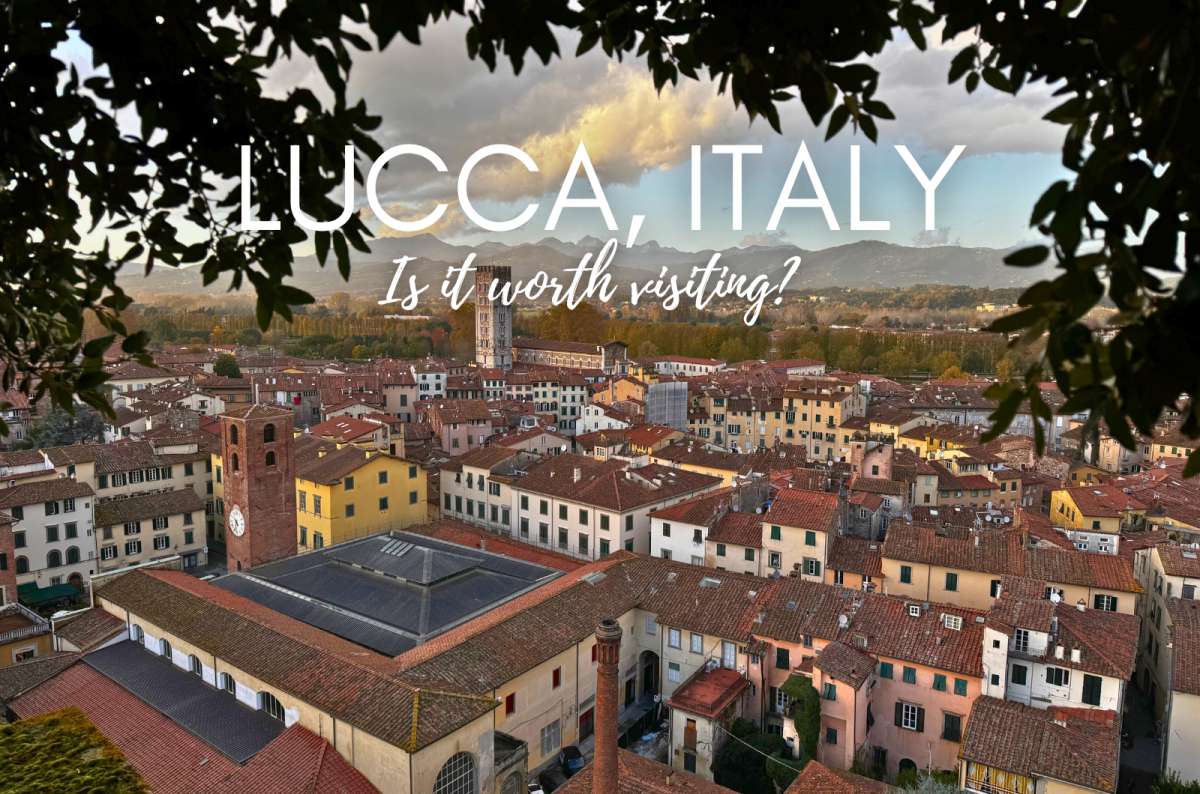
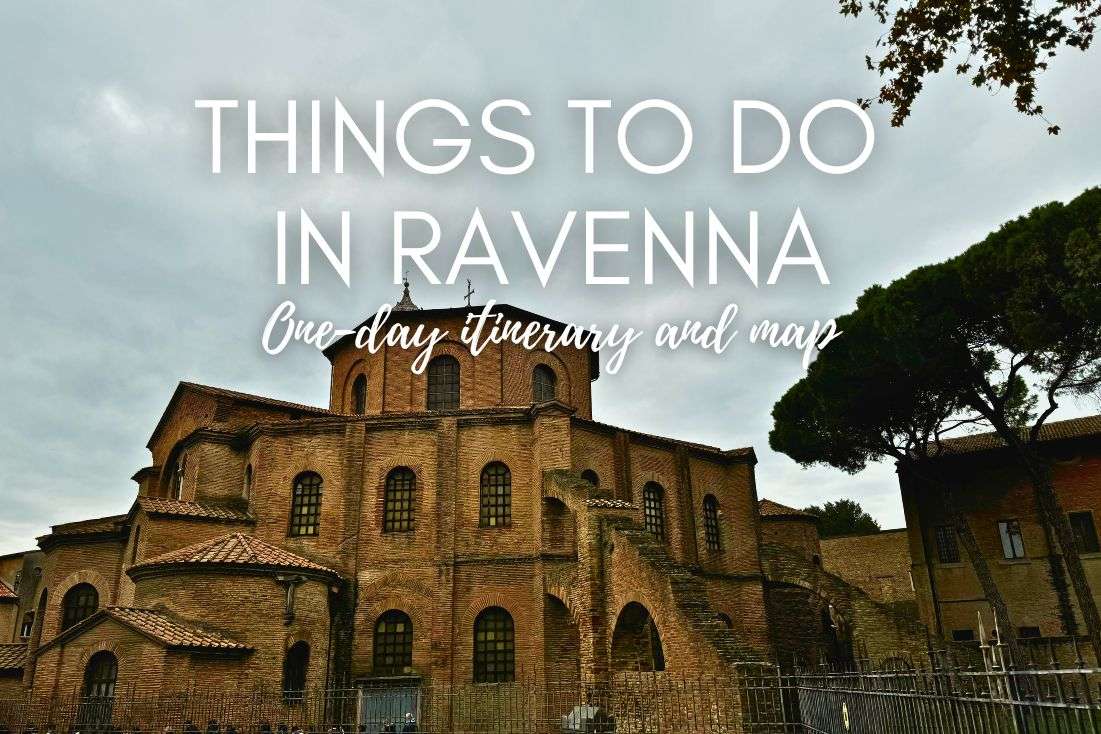




Comments | Thoughts? Give us a shout!